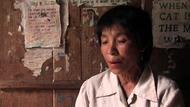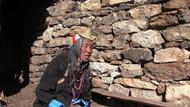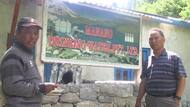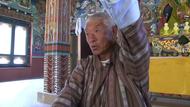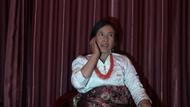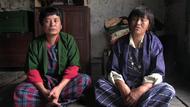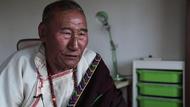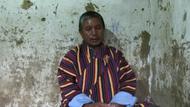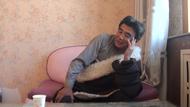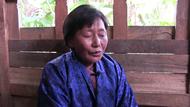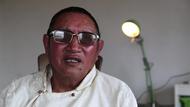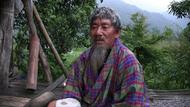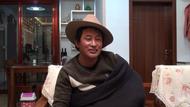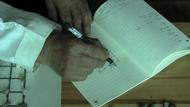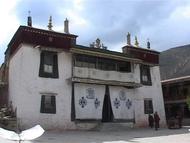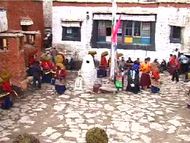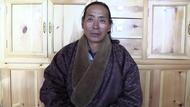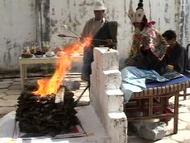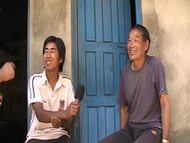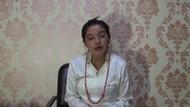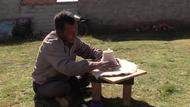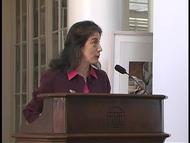Video Overview
The monk Tsultrim takes us on a tour of the chapel of the deity Ta ok, the protector of the Mé College of Sera. He explains the various deities in the chapel, the traditions of the monks who propitiate the deity, and gives an excellent account of the history of Ta ok.
- Lhasa
- Ü
- Sera Monastery
- ཚུལ་ཁྲིམསཨ་ནི་བུད་མེད་ད་ཨོའོ་ཕྲུ་གུ་མ་སྐྱེས་མཁན་རབས་ཆད་མ་ད་ང་ཚོ་བོད་རིགས་ངོས་ནས་བཤད་ན་རབས་ཆད་མ་ཟེར་ཡས་དེ་སྡུག་ག་བརྩིས་ཀྱི་རེད།Well, women who do not bear children, barren women... according to the traditions of Tibetans, barren women are seen as bad.
- ཚུལ་ཁྲིམསད་འདི་སེ་ར་སྨད་ཨ་ནི་ཐ་འོག་མགོན་ཁང་ཟེར་ཡས་དེ་རེད།So now this is the chapel of the protector Tha-Ok.
- ཚུལ་ཁྲིམསད་འདི་ག་རེ་ཟེར་དགོས་རེད་པས་དང་པོ་སེ་ར་སྨད་ད་འོ་འདི་ཆགས་དུས་ཙམ་པ་1421 ་ལོ་ལ་གྲྭ་ཚང་འདི་སེ་ར་སྨད་གྲྭ་ཚང་འདི་ད་འདུག་ཟེར་ཆགས་ཤག།Now first, in regard to the founding of this Sera Mey Tha-Ok [tradition]... In 1421 this Sera Mey College was established.
- ཚུལ་ཁྲིམསཕྱག་བཏབ་༼འདེབས་༽གནང་མཁན་གྱི་བླ་མ་དེ་ག་རེ་རེད་ཟེར་ན་ཀུན་མཁྱེན་བླ་མ་བྱང་ཆུབ་འབུམ་པ་ཟེར་ཡས་དེ་རེད་འདུགThe lama who established it was Kunkhyen Jangchub Bumpa... that's what he was called.
- ཚུལ་ཁྲིམསའདི་ཡང་ད་ཀུན་མཁྱེན་བྱང་ཆུབ་འབུམ་པ་ཟེར་ཡས་དེ་ག་རེ་རེད་ཟེར་ནའི ༼ན་ཡང་༽And now who was that Kunkhyen Jangchub Bumpa?
- ཚུལ་ཁྲིམསརྒྱལ་བ་ཡབ་སྲས་ཀྱི་ཨ་ནི་སློབ་མ་ཡིན་པ་ལ་གུང་རུ་རྒྱལ་མཚན་བཟང་པོ་ཟེར་ཡས་དེའི་སློབ་མ་ཨོའོ་དེ་འདྲས་ཅིག་༼ཤིག་༽རེད་ཤགHe was the disciple of the Victor father [Tsongkhapa] and [his spiritual] sons, and also the disciple of Gungru Gyaltsen Zangpo.
- ཚུལ་ཁྲིམསད་འདིའི་སྐབས་དེ་ག་རེ་རེད་ཟེར་ན། ད།So now what is this all about?
- ཚུལ་ཁྲིམསཨོའོ་སེ་ར་སྨད་ཐ་འོག་མགོན་ཁང་འདི་ད་ཅིག་གི་ག་རེ་ཟེར་དགོས་རེད་དེའི་ནང་ལ་ཨ་ནི་ཅིག་གི་ཨོའོ་བཤད་ཚུལ་མང་པོ་ཅིག་ད་བུད་མེད་ཕྱིན་མི་ཆོག་པ།So now what about the Sera Me Taok protector chapel? There are many things to be explained. [For example that] females are not allowed to enter.
- ཚུལ་ཁྲིམསསོགས་པ་འདི་ནང་ལ་ཨ་ནི་ཅིག་གི་ད་སྲུང་མ་འདི་ཡིན་ན་དང་པོ་ཅིག་བསམ་ཡས་ནས་ཚུར་ཨ་ནི་ཕེབས་པའི་ད་ལོ་རྒྱུས་དེ་འདྲས་མ་སོང་ནའི་འདུག་ཟེར་ཡོའོ་རེད་ཟེར།And so forth. From among these [various traditions], first, in regard to the protector, there is one concerning the way he first came here from Samye.
- ཚུལ་ཁྲིམསད་འདི་གཙོ་བོ་འདི་དེ་ག་རེ་ཟེར་ད་ང་ཚོའི་ཡི་དམ་འདི་ཡི་དམ་རྡོ་རྗེ་འཇིགས་བྱེད་ཡི་དམ་རྡོ་རྗེ་འཇིགས་བྱེད་ལྷ་བཅུ་གསུམ་རེད་ཟེར།Now the main/principle deity [of the monastery] is our yidam Vajrabhairava in the thirteen deity form.
- ཚུལ་ཁྲིམསད་འདི་དང་པོ་ང་ཚོ་ཨ་ནི་འདིའི་ནང་ལ་བསྐང་གསོ་བཏང་༼གཏོང་༽མཁན་སྔ་མ་ནས་ཡིན་ན་ད་ཨ་ནི་མགོན་པོ་བཅུ་གཉིས་མི་བཅུ་གཉིས་བྱས་ནས་འདུག་ཟེར་ཡོའོ་རེད་ཟེར།Now first of all, in our [tradition], in earlier times, there were twelve protector monks, twelve men, who were the ritual propitiators in this temple.
- ཚུལ་ཁྲིམསཨ་ནི་དང་པོ་འདིའི་ནང་ལ་བསྐང་གསོ་བཏང་༼གཏོང་༽དུས་ཙམ་པ་ཡི་དམ་འདི་ཨ་ནི་ལྷ་བཅུ་གསུམ་གྱི་ཨ་ནི་ཆོ་ག་བཏང་༼གཏོང་༽དུས་ཙམ་པར་ཡི་དམ་གྱི་བདག་བསྐྱེད་ལྷ་བཅུ་གསུམ་གྱི་བདག་་བསྐྱེད་ཟེར་ཟློས་ཚུལ་འདུག་ཟེར།And first, when they performed the propitiation ritual, that is, when they went through the ritual of the thirteen deity [form], they did the self-generation [sadhana] of the deity. There was a tradition of reciting the self-generation of the thirteen deity [form of Vajrabhairava].
- ཚུལ་ཁྲིམསད་འདིའི་སྐབས་ལ་ཨ་ནི་སྐྱབས་རྗེ་ཕ་བོང་ཁ་རིན་པོ་ཆེས་ཨ་ནི་སྐབས་དེ་དུས་ཨ་ནི་ད་ཡི་དམ་ཨ་ནི་ལྷ་བཅུ་གསུམ་གྱི་ཨ་ནི་མགོན་པོ་གང་ག་ལོགས་ལ་ལྷ་བཅུ་གསུམ་གྱི་བསྙན་པ་མེད་ན་ཨ་ནི་དཔའ་བོ་གཅིག་པའི་བདག་་བསྐྱེད་བཏོན་ཟེར་བྱས་ནས་ཨ་ནི་ད་ལྟ་ཡིན་ན་གང་ཟེར་དགོས་རེད་ད་དུས་དུས་ཙམ་མ་གཞི་ཨོའོ་ད་ལྟ་ཆ་བཞག་ན་དཔའ་བོ་གཅིག་པ་རྐྱང་རྐྱང་འདོན་གྱི་རེད་ཟེར།On this occasion, during the time of Kyabje Pabonkha Rinpoche, he advised that if all the protector monks hadn't finished the retreat of the thirteen deity yidam, they should only do the sadhana of the Solitary Hero [Yamantaka] instead. Nowadays, except on special occasions, they usually do the Solitary Hero [Yamantaka] sadhana.
- ཚུལ་ཁྲིམསཡི་དམ་གྱི་བདག་་བསྐྱེད་འདི་ད་འདི་ཡི་དམ་རྡོ་རྗེ་འཇིགས་བྱེད་འདི་དང་པོ་ཨ་ནི་་ག་རེ་རེད་ཟེར་ན། བླ་མ་སླེའུ་ཆུང་པ་བླ་མ་སླེའུ་ཆུང་པའི་ཕྱག་བཟོ་ཡིན་ཟེར་བྱས་ནས་ལོ་རྒྱུས་ནང་ལ་འདུག་ཟེར་མར་གསུངས་འདུག་ཟེར།So that's the story of the sadhana. Now what about the [statue of] the deity Vajrabhairava? It was made by Lama Lechungpa's hands. This is stated in history.
- ཚུལ་ཁྲིམསཡི་དམ་རྡོ་རྗེ་འཇིགས་བྱེད་དེ་ཨོའོ་འདུག་ཟེར་ཡིན་ཟེར།So the deity Vajrabhairava is like that.
- ཚུལ་ཁྲིམསཨོའོ་ག་རེ་ཟེར་དགོས་རེད་འདིའི་ཕར་ནང་དེ་ནས་ཚུར་ཨ་ནི་ད་འདི་མགོན་པོ་ཕྱག་དྲུག་མགོན་པོ་ཕྱག་དྲུག་་་་་་་་་མགོན་པོ་ཕྱག་དྲུག་འདི་ཨ་ནི་ད་ག་རེ་ཟེར་དགོས་རེད།Next to him on the one side is Six-Armed Mahakala... Six-Armed Mahakala. What about Six-Armed Mahakala...
- ཚུལ་ཁྲིམསཨོའོ་སྔོན་མ་གྲྭ་ཚང་ཨ་ནི་འདི་བཞེངས་སྐབས་ལ་ཨ་ནི་མགོན་པོ་ཕྱག་དྲུག་དེ་བྱས། དཔལ་ལྡན་ལྷ་མོ་དེ་བྱས། རྣམ་སྲས་དེ་བྱས། དེའི་ཕར་ནང་གི་ཆོས་རྒྱལ་དེ་བྱས། དེའི་རྣམ་སྲས་འདི་བྱས། ཨ་ནི་ལྕམ་སྲིང་དེ་བྱས། དེ་ཨ་ནི་དང་པོའི་མགོན་ཁང་དེ་ཆགས་དུས་ཙམ་པར་སྲུང་མ་གཙོ་བོ་འདྲ་དེ་ཨོའོ་དེ་གས་དེ་བྱས་བྱས། གཙོ་བོ་དེའི་ནང་གི་ལྷག་དོན་དུ་གྱུར་པ།When the monastery was first built, there was this Six-Armed Mahakala, Palden Lhamo, Namsay, and then on the other side, Chogyal, Namsay, and [then on the other side] Chamsing--these were here from the beginning of the establishmet of the protector chapel; they were the main protectors.
- ཚུལ་ཁྲིམསཐ་འོག་དེ་དེ་དུས་མེད་དུས་དེའི་ཚབ་ལ་ཨ་ནི་སྐབས་དེ་དུས་སྲུང་མ་དེ་ལྕམ་སྲིང་རེད་ཤག་ཟེར། ལྕམ་སྲིང་།At that time, when the protector Tha-Ok wasn't here, in his place... instead, Chamsing was the protector... Chamsing.
- ཚུལ་ཁྲིམསཨ་ནི་ཡན་པ་དེ་གས་མགོན་་སྐྱབས་ལྷ་ལྔ་དེ་གས་ད་ཚོ་ག་རེ་ཟེར་དགོས་རེད་ད་ང་ཚོ་རི་བོ་དགེ་ལུགས་པའི་ད་ཡིན་ན་ཅིག་གི་་མགོན་སྐྱབས་ཡིན་ན་བཅོལ་ས་མགོན་ཁང་ཟེར་ན་ད་ད་ག་རེད་པཱ།And those other ones are the five protector deities, of the Riwo Gelukpa School: the ones in whom we put our trust. "Gon Khang" means:
- ཚུལ་ཁྲིམསམགོན་ཟེར་ན་སྐྱབས་གནས་སྐྱབས་མགོན་དེ་འདྲས་བྱས་ད་ཁང་ཟེར་ན། ཁང་པ་དེ་ལ་ཟེར་གྱི་རེད་པ་ལགས་ཨོའོ་འདུག་ཟེར་བྱས་བྱས་ཨ་ནི་ད་མགོན་ཁང་དེ་འདུག་ཟེར་བྱས་བྱས་བྱུང་ཞགས་ཟེར།'Gon' means "a source of refuge," a "protector [who offers] refuge." And 'Kang' means "house/chapel," right? This is the way the protector chapel came about.
- ཚུལ་ཁྲིམསདུས་སྐབས་དེ་དུས། ད་དེ་ནས་ཨ་ནི་ཐ་འོག་དེ་ཚུར་སླེབས་དགོས་ཡས་ཀྱི་རྒྱུ་མཚན་ནི།That's how it was at one time. Now the reason that Tha-Ok needed to come over here is
- ཚུལ་ཁྲིམསདང་པོ་དེ་འདྲས་ཟེར་ད་ག་རེ་ཟེར་དགོས་རེད་ད། ཨོན་སེ་ར་སྨད་ཨ་ནི་མཁན་ཐོག་སུམ་ཅུ་སོ་དགུ་པ་མཁས་བཙུན་བློ་བཟང་དོན་གྲུབ་སྐབས་ལ་ཨ་ནི་ཐ་འོག་དེ་བསམ་ཡས་ནས་ཚུར་ཕེབས་པ་ཡིན་ཟེར།First... at the time of the 39th Sera Me Khenpo, the great abbot Losang Dondrub, Tha-Ok is said to have come here from Samye.
- ཚུལ་ཁྲིམསཚུར་ཕེབས་དོན་ག་རེ་ཡིན་ཟེར་ན། འདིའི་ཐོག་ཁ་ད་དེ་ལ་ཨ་ནི་་ཉི་མ་ལྷ་ཁང་ཟེར་ཡས་ལྷ་ཁང་གཅིག་ཡོའོ་རེད།The reason why he came here is: At the top [floor] of this [temple] there is a temple called the Sun Temple,
- ཚུལ་ཁྲིམསདེའི་ནང་ལ་ཐུབ་པ་འདྲོང་སྐེར་མ་ཟེར་ཐུབ་པ་བཞེངས་བཞུགས་ཀྱོག་༼པ་༽ཅིག་༼ཞིག་༽འདུག་ཟེར་བཞེངས་བཞུགས་ཀྱོག་༼པ་༽ཅིག་༼ཞིག་༽ཡོའོ་རེད་ཟེར།and inside that is [was?] a standing buddha called the Upright Buddha... there is a standing one
- ཚུལ་ཁྲིམསའདི་ཨ་ནི་བསམ་ཡས་དགོན་པའི་རྟེན་གྱི་གཙོ་བོ་རེད་ཟེར།This is said to have been the principal statue in Samye Monastery.
- ཚུལ་ཁྲིམསའདི་བསམ་ཡས་དགོན་པར་སླེབས་དགོས་དོན་ག་རེ་རེད་ཟེར་ན།The reason this [statue] came to Samye monastery is [as follows]:
- ཚུལ་ཁྲིམསརྒྱ་གར་ལ་སྔོན་མ་སངས་རྒྱས་བཅོམ་ལྡན་འདས་མྱ་ངན་ལས་འདས་ནས་ཐུབ་པ་འདྲོང་སྐེར་མ་དེ་སྐུ་བདུན་བཞེངས་པ་རེད་ཟེར།Previously in India, after the Buddha attained Parinirvana [i.e., died], they made seven Upright Buddha statues.
- ཚུལ་ཁྲིམསརྒྱ་གར་ལ་་་་བདུན་བཞེངས་དུས་ཙམ་པ་ཨ་ནི་དེའི་སྐབས་ལ་བསམ་ཡས་ཀྱི་ཨ་ནི་དེ་ག་རེ་ཟེར། ཨོན་་་་་་་།In India... Now when they made the seven [statues]... the one at Samye...
- ཚུལ་ཁྲིམསཆོས་རྒྱལ་ཁྲི་སྲོང་ལྡེའུ་བཙན་སྐབས་ཨ་ནི་བསམ་ཡས་ནས་པཎ་གྲུབ་མང་པོ་རྒྱ་གར་ལ་བཏང་ནས། ཨ་ནི་ཐུབ་པ་འདྲོངས་ཀེར་མ་དེ་གཅིག་བསམ་ཡས་ཀྱི་རྟེན་གྱི་གཙོ་བོ་གཅིག་རག་པ་ཡིན་ཟེར་གྱི་ཡོའོ་རེད།In the time of the Dharma King Trisong Detsen, many scholars and practitioners were sent to India, and they were able to acquire one Upright Buddha statue to be the main statue of Samye.
- ཚུལ་ཁྲིམསདེ་རག་དུས་ཙམ་པ་བསམ་ཡས་ཀྱི་ཨ་ནི་རྟེན་གྱི་གཙོ་བོ་དེ་ཉི་མ་ལྷ་ཁང་ཟེར་མཁན་ཅིག་ཡོའོ་རེད་ཟེར།When they acquired it... the main image in Samye... there is the so-called Chapel of the Sun.
- ཚུལ་ཁྲིམསད་ཨོའོ་འདི་གི་ནང་ལ་ད་ཉི་མ་ལྷ་ཁང་ཟེར་ད་ལྷ་ཁང་དེ་ལ་མིང་དེ་བཏགས་ནས་ཐུབ་པ་གྲོང་ཁྱེར་མ་འདིའི་ནང་ལ་བཞུགས་པ་ཡིན་ཟེར།It is said that, having named that temple The Sun Chapel, the Upright Buddha resided within.
- ཚུལ་ཁྲིམསདེའི་སྐབས་ལ་ག་རེ་རེད་ཟེར་ན།What happened at that time?
- ཚུལ་ཁྲིམསཨོའོ་རྒྱལ་པོ་སྐུ་ལྔ་སྐུ་ལྔ་དེ་ཨ་ནི་་བསམ་ཡས་ཀྱི་དགོན་པའི་ཨ་ནི་སྲུང་མ་རེད་ཟེར།Well, there were the Five Body Kings, the protectors of Samye Monastery.
- ཚུལ་ཁྲིམསསྲུང་མ། སྲུང་མ་དེ་གང་འདྲས་ཟེར་ཆགས་དགོས་ཀྱི་ཡོའོ་རེད་ཟེར་ན།Protectors. How did they become the protectors?
- ཚུལ་ཁྲིམསགུ་རུ་རིན་པོ་ཆེ་གིས་ཨ་ནི་སློབ་དཔོན་རིན་པོ་ཆེས་དང་པོ་བསམ་ཡས་མཆིམས་ཕུ་ཨ་ནི་ཤེལ་གྱི་ཕུག་ཟེར་མཁན་ཅིག་༼ཤིག་༽བྲག་ཕུག་ཅིག་༼ཤིག་༽དེ་ལ་བཞུགས་བསྡད་དུས་ཙམ་པ།When Guru Rinpoche was in Samye, he, Lopon Rinpoche, stayed in a cave called the Crystal Cave. And while he was staying in that cave
- ཚུལ་ཁྲིམསཨ་ནི་རྒྱལ་པོ་སྐུ་ལྔ་དེ་ལ་ཨ་ནི་དམ་འདོགས་གནངབྱས་བཀའ་བཀོད་རྡོ་རྗེ་བཀའ་བཀོད་གནང་ནས་ཨ་ནི་བསྟན་པ་སྲུང་ཡས་ཁས་ལེན་དེ་འདྲས་ཟེར་བྱས་བྱས་སྲུང་མ་ཆགས་བསྡད་ཀྱོག་ཡིན་ཟེར་གྱི་ཡོའོ་རེད་ལགས།he subdued the five kings and bound them with an oath, a vajra oath, and ordered them to protect the teachings. This is how they became protectors
- ཚུལ་ཁྲིམསད་དེ་ནས་ཨ་ནི་ག་རེ་ཟེར་གྱི་ཡོའོ་རེད་ཟེར་ན།So then what happened is...
- ཚུལ་ཁྲིམསབསམ་ཡས་ནས་ཨ་ནི་འདིའི་ཚུར་ང་ཚོ་འདིའི་སེར་ར་སྨད་ལ་སླེབས་དགོས་དོན་ནི་ཨ་ནི་དེའི་སྐབས་ལ་ཐུབ་པ་འདྲོང་སྐེར་མ་དེའི་སྐུ་གཉེར་དེ་ཨ་ནི་ད་ག་རེ་ཟེར་དགོས་རེད།The way they came here to our Sera Mey [temple] from Samye is that, at that time, the sacristan who was looking after the Upright Buddha statue,
- ཚུལ་ཁྲིམསཁོང་རང་ཅིག་ཁོང་རང་ཡིན་ཡས་བྱས་ན་ཐུབ་པ་ཚུལ་ཁྲིམས་ལ་དད་པ་ཆེན་པོ་བྱས། ཡིན་ཀྱང་ཁོང་རང་གི་ད་སྤྱོད་ལམ་འདྲ་ཅིག་ཡོའོ་རེད་པ། ཅིག་གི་ད་མཚམས་མཚམས་ཆང་འདྲ་བཏུང་། མཚམས་མཚམས་ཤོ་སྦག་འདྲ་བརྒྱབ།in actuality he had great faith in Buddha Tshulthrim [= Upright Buddha]. However, as for his conduct, you know... he, like, drank... and he, like, gambled.
- ཚུལ་ཁྲིམསཨོའོ་འདུག་ཟེར་བྱས་བྱས་ཨ་ནི་ཁོང་རང་ད་ལོ་རེ་སྔོན་མ་ནས་ཡིན་ན་དེང་སང་ནང་བཞིན་བྱས་ལྷ་བབས་གཞུང་ལ་བསྐྱལ་བྱས་བྱེད་དགོས་མ་རེད་པ་སྔོན་མ་ནས་ཡིན་ན་ལྷ་བབས་སོ་སོས་སྙལ་སོ་སོས་མཇུག་མ་དགོན་པ་ལ་གཏོང་གོ་མར་གཏོང་དགོས་རེད།So he behaved in such a way. Now every year... In earlier times, it was not like it is today, the offerings that were bestowed on the deity didn't go to the [general monatsery] administration, you know? So at that time, whatever offerings were being made to the deity, each individual [sacristan] was supposed to hang on to it, and make offerings to his own monastery [at the end of his tenure as sacristan].
- ཚུལ་ཁྲིམསཨོའོ་དེ་ནང་བཞིན་བྱས་བྱས་དེ་བྱེད་དུས་སྐབས་དེ་དུས་ཁོ་གཏོང་གོ་མར་གཏོང་ཁ་ལ་མོ་དེ་ལ་ཨོ་ཁོ་ལ་དངུལ་དང་དེ་འདྲས་མེད་པ་བྱས་བྱས་བསྟན་ཡས་ཟེར་གའི་མེད་པ་བྱས་བྱས་ད་གཏོང་གོ་མ་བཏང་ན་ཁོའི་དེའི་ནང་ལ་ལོ་ག་ཚོད་བསྡད་པ་ཡིན་ནའི་དེའི་ཡོངས་འབབ་དེ་རྩིས་རྒྱག་དགོས་རེད་པ།So that was how it was. And when the time came for him to make offerings he didn't have any money...he had nothing to show [for his time as sacristan]. If he didn't make the offerings, he would need to account for the funds for however many years he had spent looking after the temple, right?
- ཚུལ་ཁྲིམསདེ་མེད་དུས་ད་ཁོས་ང་ཆོས་ཐོག་ལ་འགྲོ་དགོས་མིན་འགྲོ་བསམ་པའི་ཁོ་རང་བློ་དེ་སྐྱེས་བྱས་ཨ་ནི་ཐུབ་པ་ཚུལ་ཁྲིམས་ལ་ཞུ་བ་ཕུལ་པ་རེད། ད་ང་འདུག་ཟེར་ཆགས་སོང་ཟེར།Because he didn't have anything, in desperation it occured to him that maybe he should run away. Then he made a plea to the Buddha Tsultrim: "This is what's come of me."
- ཚུལ་ཁྲིམསའདུག་ཟེར་ན་ཨ་ནི་ཐུབ་པས་ཁོང་རང་ད་འདི་སེམས་ཀྱི་གཏིང་ནས་ཐུབ་པ་ལ་བརྩི་པོ་ཞེ་པོ་ཡོད་པ་དད་པ་ཁོང་རང་མཁྱེན་ཙང་། ཨ་ནི་ཐུབ་པ་ཚུལ་ཁྲིམས་དེ་ཨ་ནི་དེ་ག་རེ་ཟེར་ཐུབ་པ་འདྲོང་སྐེར་མ་དེས་ཨ་ནི་གསུངས་བྱོན་བྱས།He told the Buddha what had happened. And since the Buddha knew that he had very strong faith in him in the depth of his heart... then the Buddha Tsultrim... the Upright Buddha spoke:
- ཚུལ་ཁྲིམསཁྱོད་ང་ཨ་ནི་ཚོངས་ཤོག་ཟེར་། ཁོང་རང་ཚོའི་ཐུགས་ལ་ཨ་ནི་ཁོང་རང་གྲྭ་ཚང་དེའི་་རྟེན་གཙོ་ལ་གྲུབ་ཀྱི་ཡོད་་པ་ཐུབ་པ་ཁོང་རང་གིས་མཁྱེན་ཚར་པ་རེད་པཱ།"You should sell me." The Buddha already knew that he, the Buddha, would end up becoming the chief image of this College, right?
- ཚུལ་ཁྲིམསསླེབས་ཀྱི་ཡོད་པ་ང་ཚོངས་ཤོག་ཟེར་ཚོངས་ཤོག་ཟེར་དུས། ཨ་ནི་ཁོང་རང་གིས་ཨ་ནི་ཐུབ་པར་ད་་སྐད་ཆ་འཚོང་སྟངས་འཚོང་ལུགས་གང་འདྲས་ཟེར་དགོས་རེད་ཟེར་ད་ང་།So he said "sell me." And then he [the sacristan] asked the Buddha: "How can I sell you? How would I go about selling you?"
- ཚུལ་ཁྲིམསད་དེ་ལ་ཨ་ནི་མི་ལ་ལན་འདོགས་མེད་པ་ཅིག་༼ཞིག་༽བྱེད་དགོས་རེད་ཟེར་ད་དེ་གང་འདྲས་ཟེར་བྱེད་དགོས་རེད་ཟེར་དུས་ཨ་ནི་ཐུབ་པ་ཚུལ་ཁྲིམས་ཀྱིས་དེ་ཁྱོད་རང་གའི་བྱེད་ཀྱི་མ་རེད་ཟེར།"I shouldn't be the person who gets blamed. How should I then go about it?" The Buddha Tshultrim said, "You needn't worry."
- ཚུལ་ཁྲིམསཨན་༼ཨ་ནི་༽ངས་བྱེད་ཟེར་ཡས་དེ་ཚང་མ་དེ་བྱེད་ཟེར་ཨ་ནི་ཁྱེད་ར་༼རང་༽ཨ་ནི་དེ་བྱེད་ཟེར།"Do whatever I tell you to do... just do it" he said.
- ཚུལ་ཁྲིམསཨོའོ་ཐུབ་པ་ཚུལ་ཁྲིམས་ཨ་ནི་བསམ་ཡས་ཀྱི་རྟེན་གཙོ་གནམ་ལ་ཕུར་སོང་། གསུངས་ཟེར་ལབ་ཤོག་ཟེར་སྐད་བརྒྱབ་ཤོག་ཟེར། ཨ་ནི་ང་ཚོས་ཁྱེད་རང་ལྷ་སར་འདུག་ཟེར་འཚོང་གག་རྒྱུགས་ཟེར་དུས་ཨ་ནི་ཁོས་འདུག་ཟེར་སྐད་བརྒྱབ་དུས་ཙམ་པ་ཨ་ནི་མི་མང་པོས་ཐུབ་པ་ཚུལ་ཁྲིམས་ནམ་མཁའ་ལ་ཕུར་ཐུབ་པ་འདྲོང་སྐེར་མ་ནམ་མཁའ་ལ་ཕུར་འགྲོ་བ་མི་མང་པོས་མཐོང་བ་རེད།"Say that Buddha Tsultrim, the main statue of Samye, flew away into the sky. Tell [them], yell it! Then we... you... go to sell [me] in Lhasa like so." When he [the Buddha] said this, then he [the sacristan] yelled just like that, and when he exclaimed thus, many people saw the Buddha Tsultrim flying in the sky--many people saw the Upright Buddha go flying into the sky.
- ཚུལ་ཁྲིམསམཐོང་དུས་ཙམ་པར་ད་ཁོ་གཞུ་གུར་སྐུ་གཉེར་ཁོ་ལབ་གླེང་མེད་པ་ཆགས་པ་རེད་པ།Since they saw that, then later the sacristan became free of blame, right?
- ཚུལ་ཁྲིམསཨན་༼ཨ་ནི༽ཁོ་ཕར་ནས་ཚུར་ཡོང་དུས་ཙམ་པ་ཐུབ་པ་ཚུལ་ཁྲིམས་སྔོན་ལ་ཕེབས་དེའི་གཞུ་གུར་སྐུ་གཉེར་ཁོ་ཚུར་ཡོང་རྒྱུ་བྱས་བྱས་དེར་སྒུག་རྒྱུ་བཟོས། འདུག་ཟེར་བྱས་ལྷ་སར་འཚོང་གག་ཡོང་བ་རེད་ཟེར།So when he came back from there, they had planned that the Buddha Tsultrim would go first, and then he would come later and [the Buddha] would wait for him there. In such a way, they came to Lhasa to sell him.
- ཚུལ་ཁྲིམསལྷ་སར་འཚོང་གག་ཡོང་དུས་ཙམ་པ་ཨ་ནི་དེའི་སྐབས་ལ་མཁན་ཐོག་སུམ་ཅུ་སོ་དགུ་པ་ཨ་ནི་མཁན་ཆེན་བློ་བཟང་དོན་གྲུབ་གྱི་གཟིམ་ལམ་ལ་ཨ་ནི་ག་རེ་བྱུང་པ་༼བ་༽རེད་ཟེར་ན།When [they] came to Lhasa to sell him, then, at that time, the abbot, the thirty-ninth, the great abbot Lobsang Dondrub, had a dream. So what happened was,
- ཚུལ་ཁྲིམསཨ་ནི་རྦད་དེ་འོད་ཟེར་རྦད་དེ་ཁྱོན་ནས་ལྷ་སའི་བར་སྐོར་ནང་ནས་ཨ་ནི་འོད་ཟེར་རྦད་དེ་ཕྱོགས་བཅུ་མཐའ་ཡས་པ་ལ་འཕྲོས། དེ་འཕྲོས་པ་དེས་ཨ་ནི་སེམས་ཅན་མཐའ་ཡས་པའི་ལུས་སེམས་ལ་མར་འཐིམས། སེམས་ཅན་ཐམས་ཅད་ཀྱི་ལུས་ངག་ཡིད་གསུམ་ཀྱི་སྒྲིབ་པ་དག་པ།in the dream from around Lhasa, [the abbot saw] rays of light totally radiating from the Lhasa Barkhor [Central Plaza] throughout the ten directions, immeasurably emanating and dissolving into the bodies and minds of immeasurable sentient beings, purifying all sentient beings' obscurations of body, speech, and mind.
- ཚུལ་ཁྲིམསདེ་འདྲས་ད་ཨ་ནི་ཁོང་རང་གི་གཟིམ་ལམ་ལ་ད་གཉིད་ལམ་རེད་པ་གཟིམ་ལམ་ཟེར་དུས་ད་གཉིད་ལམ་ཨོ་དེ་འདྲས་བྱུང་ནས་དེའི་འོད་ཟེར་སྣེ་མོ་གཅིག་གང་ཡིན་ཟེར་ན་སེ་ར་སྨད་གྲྭ་ཚང་ལ་ལྷ་ས་ནས་སེ་ར་སྨད་གྲྭ་ཚང་ལ་འཕྲོས་པའི་གཟིམ་ལམ་རྟགས་ མཚན་མ་དེ་འདྲས་མང་པོ་བྱུང་བ་རེད་ཟེར།So like that, his dream, you know, a dream, right? When you say ziglam [dream, honorific] it is nyilam [dream, non-honorific], okay? His dream indicated that from these rays of light one ray of light came out from Lhasa to the monastery of Sera Me. There occurred many signs.
- ཚུལ་ཁྲིམསདེ་བྱུང་ཙང་ཨ་ནི་ཁོང་གིས་སང་ཉིན་གསོལ་དཔོན་དེ་ལ་མངགས་ནས་ད་ཁྱོད་རང་དེ་རིང་ལྷ་སར་ཕྱིན་བྱས་ཨ་ནི་ཁྱོད་རས་ད་ཅ་ལག་འོད་ཆེན་པོ་ཅིག་ཡོད་ཟེར། ད་དེ་ད་གོང་ག་ཚོད་ཤོར་ནའི་ཉོས་ཤོག་ཟེར་གསུངས་པ་རེད།Since that happened, the next day he [the abbot] summoned his attendant, and said "Today you go to Lhasa, and if you see something really luminous, pay whatever they ask and buy it."
- ཚུལ་ཁྲིམསདེ་གསུངས་དུས་ཙམ་པ་ཁོ་ཤ་གསར་ཟུར་ད་ལྟའི་ཤ་གསར་ཟུར་དེ་ནས་ཕར་འགྲོ་དུས་ཙམ་པ་ཨ་ནི་ཁོས་ཨོའོ་ཅ་ལག་དེ་ཐུབ་པ་ཚུལ་ཁྲིམས་ཐུབ་པ་དེ་སྒལ་པར་འཁྱེར་བྱས་ཡོང་པ་གང་ལྟར་མཐོང་བ་རེད་གསོལ་དཔོན་དེས།When he [the abbot] said that, he [the attendant] went to the corner of Shasar, and saw someone coming carrying this object, the Buddha Tsultrim [statue] on his back... anyway, he, the attendant saw [that].
- ཚུལ་ཁྲིམསཨན༼ཨ་ནི་༽གསོལ་དཔོན་དེའི་བསམ་པ་ལ་དེ་ཡིན་པ་རེད་བསམས་ནས་ཁོས་ནི་ཁྱོད་སྐུ་དེ་འཚོང་ཡས་ཡིན་པས་འཚོང་ཡས་ཡིན་ན་ངས་ཁྱེད་རང་ལ་རིན་པ་བརྒྱ་ལོན་པ་སྤྲད་ཀྱི་ཡིན་ཟེར།And so the attendant thought that maybe this was it, and he asked the man, "Are you going to sell that statue? If you are going to sell it, I will give you the best price for it."
- ཚུལ་ཁྲིམསཨན་༼ཨ་ནི༽ཁོང་རང་དགའ་པོ་ཞེ་དྲགས་བྱུང་བྱས་ཁོ་འཚོང་གག་ཡོང་མཁན་ཨ་ནི་ཁོས་འཚོང་གི་ཡིན་ཟེར།So he, [the sacristan from Samye] who had come to sell it, became extremely happy and said he would sell it.
- ཚུལ་ཁྲིམསཨོའོ་འདུག་ཟེར་བཙོངས་བྱས་གང་ལྟར་ད་གསོལ་དཔོན་དེ་སྐབས་དེ་དུས་ག་རེ་རེད་ཟེར་ན།So in that way he sold it. Anyway, what the attendant did at that time was...
- ཚུལ་ཁྲིམསལྕགས་རོང་ཅི་ཅག་ལ་སླེབས་དགོས་ཡས་རྒྱུ་མཚན་ག་རེ་རེད་ཟེར་ན།How did they end up at Chagrong Chichak?
- ཚུལ་ཁྲིམསཕར་ནས་ཡར་བྱས་བྱས་དེའི་སྐབས་ལ་ཕར་ནས་ཡར་ལམ་ལམ་ཁ་དང་དེ་འདྲས་ཡོའོ་མ་རེད་པཱ། ཕར་ནས་ཡར་གོམ་པ་རྒྱབ་ཕྱིན་བྱས་ལྕགས་རོང་ཅི་ཅག་ཟེར་ཡས་དེ་ལ་དགོང་མོ་གཅིག་གསོལ་དཔོན་ཁོང་རང་གིས་ངོ་ཤེས་ཀྱི་ཡོད་པ་འདྲ་འདུག་ག དེར་དགོང་མོ་གཅིག་ཞག་སྡོད་བྱས་པ་རེད་ད།Up from there, at that time the pathway going there had no streets or anything, you know? He was walking up from there and he came to the household known as "Chagrong Chichak." So one night--- the attendant himself it appears knew them (the family)---he placed it there and they stayed for one night [at the Chagrong Chichak home].
- ཚུལ་ཁྲིམསཞག་སྡོད་བྱས་བྱས་ད་ཁྱིམ་ཚང་དེ་ལ་ད་ཅིག་ག་རེ་ཟེར་དགོས་རེད་ད་བལྟ་བས་མི་ངོམས་པའི་ཆོག་མི་ཤེས་པའི་བཟོ་འདྲ་ཅིག་ད་སྐྱིད་པོ་ཞེ་པོ་ཅིག་བྱུང་བྱས་ད་སྐུ་དེ་ཕེབས་ཙང་ཁྱིམ་ཚང་དེ་ལ་སྤྲོ་བ་ཞེ་པོ་ཅིག་སྐྱེས་ནས་ཨ་ནི་་སྐབས་དེ་དུས་ཙམ་པ་ཁྱིམ་ཚང་དེ་ལ་ཨ་ནི་སྲུང་མ་ཐ་འོག་དེ་སྲུང་མ་ཕར་ནས་ཚུར་སྐུ་དེའི་རྗེས་འབངས་༼འབྲངས༽ཡོང་བ་རེད་པཱ།He placed the statue [in their home]; and that family, they seemed insatiable in [their desire to] gaze upon [the statue]; it seemed that no matter how much they looked, they were not satisfied. Now they were tremendously happy that the statue had come to their home. Thus they were extremely pleased. At that time, the [statue's] protector Tha-Ok came over to the family's home from there [Samye] following the statue, right?
- ཚུལ་ཁྲིམསད་སྲུང་མ་ད་ཁོ་འདུག་ཟེར་དངོས་སུ་ང་རང་ཚོ་མིག་གིས་མཇལ་ཡས་ཡོའོ་མ་རེད་པ།Now we can't see that protector with our own eyes as he is, right?
- ཚུལ་ཁྲིམསཡིན་ནའི་ལྕགས་རོང་ཅི་ཅག་ལ་ཨ་ནི་དངོས་སུ་ཁོ་ར་སྲུང་མ་དེ་མཇལ་ལ་༼བ་༽ཡིན་ཟེར་གྱི་ཡོའོ་རེད།But in the Chagrong Chichak [household] the protector was actually seen.
- ཚུལ་ཁྲིམསཁྱིམ་ཚང་དེའི་མི་ལ་མཇལ་ལ་༼བ་༽ཡིན་ཟེར་སྲུང་མ་དེ་དེ་འདྲས་ཀྱི་བརྟེན་ནས་ཨ་ནི་ཁྱིམ་ཚང་དེ་རྦད་དེ་དེའི་དགོང་དག་གསོལ་དཔོན་དེ་དང་ཁོང་རང་ཚོས་མཆོད་པ་རྒྱས་པར་བཤམས་བྱས་ད་ཞབས་ཏོག་ཡག་པོ་ཅིག་༼ཞིག་༽ཕུལ་ནས་ཨ་ནི་ཁོང་རང་ཚོ་ནང་མི་ཚང་མ་ལོགས་དད་པ་རྩེ་གཅིག་ཏུ་བསྐྱེད་པའི་རྒྱུ་རྐྱེན་གྱིས་ཨ་ནི་གང་བྱས་གཞུ་གུར་སྲུང་མ་དེ་འདིར་སླེབས་དུས་ཙམ་ནས་ཨ་ནི་ལྕག་རོང་དེ་ནང་མིའི་བཟོ་འདྲ་འདྲ་ཅིག་ཆགས་པ་ཡིན་ཟེར།Someone of that house said he saw it, the protector, and based on that, that evening, the whole family and the attendant arranged extensive offerings to the statue, rendering good service. They, the entire family, all generated faith single-pointedly, and due to these causes and conditions, later when the protector came here, he became like a member of the Chagrong household.
- ཚུལ་ཁྲིམསད་ལྕག་རོང་ཅི་ཅག་གིས་ཨ་ནི་ཁོང་རང་གིས་མི་བརྒྱུད་ད་དེའི་ནང་ཚན་གི་ད་ཕོ་མོ་བུ་ཡིན་ནའི་འདྲ། བུ་མོ་ཡིན་ནའི་འདྲ། གང་ག་ལོགས་འདིའི་ནང་ལ་ཡོང་ཆོག་པའི་རྒྱུ་མཚན་ད་མ་སོང་ནའི་ཨོའོ་འདུག་བཟོ་ནང་གི་བཟོ་འདྲ་ཐོག་མ་དེ་འདུག་ཟེར་ཆགས་པ་རེད་ཟེར།Now for that reason any male or female member of the Chagrong Chichak family, whether a boy or a girl, all of them are allowed into [this chapel]. That is how [this tradition of the exemption for the Chagrong family] first came about.
- ཚུལ་ཁྲིམསད་དེ་ནས་ཨ་ནི་གྲྭ་ཚང་གིས་འདིར་་ཡར་གདན་འདྲེན་ཞུས་ནས་ཨོའོ་ག་རེ་ཡིན་ཟེར་ན།Then, what happened after the college invited [the Buddha statue] up here was...
- ཚུལ་ཁྲིམསགྲྭ་ཚང་གི་མཁན་པོ་མཁན་ཆེན་བློ་བཟང་དོན་གྲུབ་གིས་ཨ་ནི་ཐུབ་པ་འདྲོང་སྐེར་མ་དེ་འདིའི་ཐོག་ག་དེར་གདན་འདྲེན་ཞུས་གྲྭ་ཚང་གི་རྟེན་གྱི་གཙོ་བོར་གྱུར།The monastery abbot, the great abbot Lobsang Dondrub, brought the Upright Buddha to a [second-]story chapel of the temple and it became the main statue of the monastery.
- ཚུལ་ཁྲིམསདེ་ལ་ཨ་ནི་རྦད་འདིའི་ནང་ལོགས་ལ་རབ་གནས་དང་མཆོད་པ་དང་ལ་སོགས་པ་གང་རྒྱས་ཤིང་འཚམས་པ་ཁོ་དེ་གནང་བྱས་གང་ཡིན་ཟེར་ན།And for that, in this [temple], they did the whole consecration, offering, and so forth as extensively as possible.
- ཚུལ་ཁྲིམསཨ་ནི་ཐུབ་པ་ཐ་འོག་འདི་ཐུབ་འོག་ཟེར་འདུག་བཟོ་བྱས་བྱས་ཐུབ་པའི་འོག་དེར་སྡོད་ཟེར།Now Tubpa [Buddha], [I mean] this Tha-Ok [derives from] the words Thub and Ok, [thub = Buddha][og = beneath; under]"under the Buddha," because [Tha-Og] was told "stay under the Buddha."
- ཚུལ་ཁྲིམསཁྱེད་རང་ཐུབ་པའི་འོག་ལ་སྡོད་ཟེར་བྱས་བྱས་ཁོང་རང་གི་ཨ་ནི་བློ་སྟོབས་ཆེན་པོའི་ངང་ནས་ཨ་ནི་གྲྭ་ཚང་གི་སྲུང་མ་ལ་མངའ་གསོལ་ལྕམ་སྲིང་ལ་ཨ་ནི་ཡར་འདུག་ཟེར་བྱས་བྱས་མངའ་གསོལ་གྱི་ཡིན་ཟེར་བྱས་བྱས་འདུག་ཟེར་སྙན་གསེང་མ་སོང་ནས་ཞུས་་གྲྭ་ཚང་གི་སྲུང་མ་ལ་ཐུབ་འོག་དེ་མངའ་གསོལ།"You, reside underneath the Buddha." Later, with great determination, he was installed as the main protector of the [Sera Mey] College. Chamsing was installed over there, and they reported to him [Chamsing] that they were going to install Thub-Ok as the protector of the College.
- ཚུལ་ཁྲིམསཐ་འོག་འདིར་བཞུགས་རྒྱུ་བྱས་ཁྱེད་རང་ཐུབ་འོག་ཟེར་ཐུབ་པའི་འོག་དེར་བཞུགས་ཨ་༼ཨང་༽ཟེར།So Tha-Ok was placed there. And they called him Thub-Ok [literally "under the Buddha"]. They told him to abide under the Buddha [in this first floor chapel underneath the Upright Buddha chapel above].
- ཚུལ་ཁྲིམསད་ཆ་ཡིན་ན་ད་གོ་བདེ་བ་དང་བླངས་བདེ་བའི་སྐད་ཀྱིས་ཨ་ནི་ཐ་འོག་ཟེར་ཆགས་པ་མ་གཞི་དངོས་སུ་དངོས་གནས་ཡིག་གེའི་དག་ཆ་བྱས་པ་ཡིན་ན་ཐུབ་འོག་རང་རེད་ཤགNowadays, in a language that is easier to understand and pronounce, it has become Tha-Ok (instead of Thub-Ok). However, in actuality it is spelled Thub-Ok (not Tha-Ok).
- ཚུལ་ཁྲིམསཐུབ་པ་ཐུབ་པའི་འོག་དུ་བཞུགས་མཁན་ཡིན་ཡས་བྱས་ན་ཤར་ཕྱོགས་རྒྱལ་པོ་སྐུ་ལྔའི་ནང་ནས་ཆ་བཞག་ན་ཤར་ཕྱོགས་སྐུ་ཡི་རྒྱལ་པོ་ཟེར་ཡས་དེ་རེད།The one who lives under the Buddha. But in actuality, [he] is the eastern,... within the five kings, [Tha-Ok] is said to be the body-king of the eastern direction.
- ཚུལ་ཁྲིམསཤར་ཕྱོགས་སྐུ་ཡི་རྒྱལ་པོ་དེ་ཨོང་ག་རེ་རེད་ཟེར་ན།So who is the body-king of the eastern direction?
- ཚུལ་ཁྲིམསསངས་རྒྱས་སྣང་བ་མཐའ་ཡས་ཀྱི་སྤྲུལ་པ་ཡིན་ཟེར་གྱི་ཡོའོ་རེད།He is said to be an emanation of the Buddha Amitabha (Buddha of Limitless Light).
- ཚུལ་ཁྲིམསསངས་རྒྱས་སྣང་བ་མཐའ་ཡས། ངེས་དོན་ལ་སངས་རྒྱས་སྣང་བ་མཐའ་ཡས་ཀྱི་སྤྲུལ་པ་དྲང་དོན་ལ་ཡིན་ན་ད་དྲེགས་པའི་ཚུལ་བསྟན་བྱས་ཨ་ནི་སངས་རྒྱས་ཀྱི་བསྟན་པ་སྲུང་ཀྱི་ཡོད་ཟེར།Buddha Amitabha...In his definitive nature he [Tha-Ok] is an emanation of Buddha Amitabha. At the provisional level he manifests a wrathful manner and protects the teachings of the Buddha.
- ཚུལ་ཁྲིམསཁོ་རྒྱུ་མཚན་ཨོང་དེ་རེད་བྱས་ཙང་། ཡིན་ཡས་སངས་རྒྱས་ཀྱི་སྤྲུལ་པ་ཡིན་པ་ལ་ད་ང་ཚོས་དྲང་དོན་ལ་ཡིན་ན། ཨ་ནི་ཅིག་ད་ག་རེ་ཟེར་དགོས་རེད་ཐ་འོག་གི་ཁོང་རང་གིས་སངས་རྒྱས་ཤར་ཕྱོགས་རྒྱལ་པོའི་སྤྲུལ་སྐུ་བཞེས་བྱས་དྲེགས་པའི་ཚུལ་བསྟན་པ་དེ་འདྲས་བྱས་བྱས། ཨ་ནི་སངས་རྒྱས་ཀྱི་བསྟན་པ་སྲུང་ཡས་ཀྱི་ཆེད་དུ་དེ་འདྲས་གནང་བ་ཡིན་ཟེར།That is the reason. Therefore, in reality he is an emanation of the Buddha, but for us, at the level of the provisional... Tha-Ok adopts the Buddha emanatiion of the body-king of the eastern direction, manifesting a wrathful manner in order to protect the teachings of Buddha.
- ཚུལ་ཁྲིམསད་ཨོའོ་འདུག་ཟེར་ཐུབ་འོག་ཟེར་ཡས་དེ་གང་བྱས་ཐ་འོག་ཟེར་ཡས་དེ་དང་ཐུབ་འོག་ཟེར་ཡས་ད་ཨོའོ་འདུག་ཟེར་ཡིག་གེའི་ཅིག་གི་ད་ག་རེ་ཟེར་དགོས་རེད། ཚུར་ཚུར་ཅིག་ཆགས་ཡོང་དུས་ཙམ་པ་ཅིག་གི་གོ་བདེ་བ་དང་བཀླག་བདེ་བའི་རྐྱེན་གྱིས་ཐུབ་འོག་དེ་ཐ་འོག་ཟེར་ཡིག་གེ་དེ་ཐ་ཐ་རྐྱང་རེད། ཡིག་གེ་དེ་འོང་འདུག་ཟེར་བྱས་བྱས་ཆགས་བསྡད་ཡོའོ་རེད་ཟེར།So that's it, Thub-Ok. There is "Tha-Ok" and there is "Thub-Ok," but written the same. But later to make it simpler and for the sake of euphony, they call "Thub-Ok" "Tha-Ok." The [first] letter became a plain "tha" [as opposed to the original "thub"].
- ཚུལ་ཁྲིམསདེང་སང་ད་མི་མང་པོ་ཅིག་གི་གང་ག་ལོགས་ཀྱིས་ཐ་འོག་ཐ་འོག་ཟེར་རྐྱང་རྐྱང་ཐ་འོག་རྐྱང་རྐྱང་གོ་བདེ་བའི་ཁྱད་བྱས་བྱས་ཨོའོ་འདུག་ཟེར་འབོད། འབོད་སྲོལ་ཨོའོ་འདུག་ཟེར་རེད་ཟེར།These days many people say, everyone says "Tha-Ok," only "Tha-Ok," since it is simpler. So that is how the custom of calling him [with this name came about].
- ཚུལ་ཁྲིམསད་བུད་མེད་ཕྱིན་མི་ཆོག་པ་དེ་རྒྱུ་མཚན་ག་རེ་རེད་ཟེར་ན།The reason that women are not allowed to enter [this temple ] is...
- ཚུལ་ཁྲིམསསྐབས་དེའི་སྐབས་ལ་ཨ་ནི་ཨོའོ་གྲྭ་ཚང་འདིའི་ཨ་ནི་ཐོག་ཁ་དེ་གས་དེ་མེ་ཤོར་ཤག་དེའི་སྐབས་ལ་གྲྭ་ཚང་འདི་ག་ཙམ་ཆེན་པོ་འདི་འདྲས་མེད་འདུགat one time there was a fire that destroyed the top part of this College [temple]. At that time the College [temple] wasn't this big.
- ཚུལ་ཁྲིམསའདིའི་འོག་གི་འདུ་ཁང་དེ་གའི་ཆེན་པོ་དེ་མེད་པ་བྱས་འདིའི་ཕར་ནང་དེ་གཙོ་བོ་གཙོ་བོ་དེ་འདིའི་ཕར་ནང་གི་དང་པོ་ཐོག་མ་འདི་ཆགས་དུས་འདིའི་ཕྱོགས་གྱི་དུས་གསུམ་ལྷ་ཁང་དེ་ཆགས་པ་རེད།The main meeting hall that's down there did not exist. Instead, it was the [room] over there that was the principal [meeting hall]. It was that one over there, that was the first [meeting hall] that came about when [the monastery] was first [built]... the one in that direction that [today is called] the chapel of [the Buddhas of] the Three Times.
- ཚུལ་ཁྲིམསདེ་ཡ་ཨ་ནི་འདིའི་སྐབས་ལ་ཨ་ནི་གྲྭ་ཚང་གི་ཐོག་ཁ་དེ་གས་དེ་ལེབ་དེ་༼ཡོད་ཚད་ཐམས་ཅད་༽མེ་ཤོར་ཤགAt this time, then, the upper story of the temple caught on fire.
- ཚུལ་ཁྲིམསཐོག་བརྩེགས་གཉིས་ཐོག་གཅིག་བརྒྱབ་བྱས་ཐོག་བརྩེགས་ཉིས་ཐོག་རང་བརྒྱབ་ཤགThere were two stories [to the temple], only two stories.
- ཚུལ་ཁྲིམསད་ལྟའི་ཐོག་བརྩེགས་མཐོ་པོ་དེ་འདྲས་མིན་འདུག གཉིས་ཐོག་བརྒྱབ་དུས་གྲྭ་ཚང་ལ་མེ་ཤོར་བྱས་གཙོ་བོ་ཤོར་དགོས་དོན་གང་འདྲ་རེད་ཟེར་དུས་ཙམ་པ།The floors weren't as high as they are today. And when they built the second story, how did the main floor of the temple catch on fire?
- ཚུལ་ཁྲིམསདེ་འདྲས་ཅིག་ཨ་ནི་གང་བྱས་ནི་་དེའི་གྱི་ནང་ལ་ཕྱིན་ཤག་དེའི་རིགས་དེ་གས་དེ་མ་གཏོང་ཟེར་བྱས་བྱས་བུད་མེད་ཨོའོ་འདུག་ཟེར་བཀག་དགོས་ཡས་རྒྱུ་མཚན་ཨོའོ་འདུག་ཟེར་བཀག་ཤག་དང་པོ་ཐོག་མ།It turned out that one of those women entered the temple. [And this is what caused the fire.] And this is how the [tradition] of prohibiting [all women from entering] first came about... it was originally a prohibition against admitting [barren women].
- ཚུལ་ཁྲིམསདེ་བཀག་དུས་ཙམ་པར་ག་རེ་རེད་ཟེར་ན།When they made this restriction, what happened was:
- ཚུལ་ཁྲིམསད་བུད་མེད་རབས་ཆད་མ་དེ་ཕྲུ་གུ་མ་སྐྱེས་མཁན་དེ་མ་གཏོང་ཟེར་དུས་ཙམ་པ་ད་བུད་མེད་སྤྱི་ཁོ་རང་མ་བཀག་པ་ཁོ་བཀག་ཤེས་ཀྱི་མ་རེད་པཱ།Now when they said not to admit barren women, those who cannot bear children, they knew no way to restrict [barren women alone] without restricting all women.
- ཚུལ་ཁྲིམསཨོའོ་འདུག་ཟེར་བྱས་བྱས་རྒྱུ་མཚན་འདུག་ཟེར་བཀག་ཤག་མ་གཞི་ད་ལྷག་དོན་དུ་འདིའི་ནང་བུད་མེད་ཕྱིན་ནས་ཉེས་པ་འདི་ཡོད་འདི་ཡོད་ཟེར་མཛུག་གུ་མཛུགས་ཡས་ཁས་ཟེར་མེད་འདུགIn that way, the restriction [was made]. But saying that there are these transgressions that exist when women enter is not to point a finger at women per se.
- ཚུལ་ཁྲིམསཨོའོ་འདུག་ཟེར་བྱས་བྱས་ད་བུད་མེད་གཅིག་དཔེར་ན་ཆ་བཞག་ན་དེ་དབྱེ་བ་འབྱེད་ཤེས་གྱི་མ་རེད་པ་ད་དཔེ་ཁག་པོ་ཞེ་པོ་རེད་པཱ། བུད་མེད་སྤྱི་འོང་འདུག་ཟེར་བཀག་དགོས་ཡས་རྒྱུ་མཚན་ཨོའོ་འདུག་ཟེར་ཐུག་ཤགSo, in this way, well, for example, there is no way to discern who is one of those women, is there? It is very difficult. This, therefore, is the reason why women in general must be prohibitted [from entering].
- ཚུལ་ཁྲིམསགྲྭ་ཚང་གི་ག་རེ་ཟེར་བུད་མེད་ད་རབས་ཆད་མ་ཅིག་གི་འདུག་ཟེར་བྱས་བྱས་དེའི་ནང་གི་སྲུང་མ་དེ་ལ་འབག་བཙོག་ཤོར་ཤགSo a barren women entered into the College [protector chapel], and thus the protector within became contaminated.
- ཚུལ་ཁྲིམསབྱས་ཙང་གྲྭ་ཚང་གི་ཐོག་ཁ་མེས་འཚིགས་པ་རེད་སྲུང་མ་དེ་ཁོང་རང་ཁྲོས་པའི་ཚུལ་བསྟན་ནས་རྒྱུ་མཚན་མ་སོང་ན་ཨོའོ་འདུག་ཟེར་བྱས་བྱས་ཨོའོ་ཨ་ནི་བུད་མེད་སྤྱི་བཀག་དགོས་ཡས་རྒྱུ་མཚན་འདྲ་དེ་ཨོའོ་འདུག་ཟེར་རེད་ཤགTherefore, the upper story of the College [temple] was incinerated... the protector manifested his wrath. So in this way, this is one reason why women in general must be prohibited [from entering this chapel].
- ཚུལ་ཁྲིམསད་ལྟ་སྔོན་ལ་འགྲེལ་བཤད་ཞུ་ཡས་ཀྱི་ཐ་འོག་ཟེར་ཡས་སྲུང་མ་དེ་འདི་རེད།So the protector Tha-Ok about whom I just gave an explanation is this one.
- ཚུལ་ཁྲིམསད་འདི་ཨ་ནི་སྔོན་མ་ནས་ཡིན་ན་ད་སྲུང་མ་གཙོ་བོ་འདི་རེད།Now this is the original main protector.
- ཚུལ་ཁྲིམསད་ཆ་ཆ་བཞག་ན་ད་འདི་ཅིག་ག་རེ་ཟེར་དགོས་རེད། སྔོན་མ་གི་ཐ་འོག་འདི་རིག་གནས་གསར་བརྗེ་ཆེན་པོའི་རྗེས་ལ་ཨ་ནི་ཐ་འོག་འདི་གཏོར་སྐྱོན་བྱུང་ནས་ཨ་ནི་ག་རེ་རེད་ཟེར་ན།By comparison to what we have here today... in earlier times... the [original] Tha-Ok [statue] was destroyed after the Great Cultural Revolution. So then what happened was,
- ཚུལ་ཁྲིམསཁོང་རང་ཐ་འོག་འདི་གཏོར་ནས་ཁོང་རང་གི་ད་ཞལ་འབག་གཅིག་ཡོའོ་རེད་པ་ཞལ་རས་དེ་འདིའི་འོག་དེར་ལྷག་བསྡད་ཡོའོ་རེད་ཟེར།This Tha-Og [statue] was destroyed, but his mask, his face, was left under this [table]:
- ཚུལ་ཁྲིམསལྷག་བསྡད་ཡོའོ་རེད་ད་འདི་ག་རེ་ཟེར་ན་བརྒྱ་བཅུ་གྱ་གཅིག་༼སྤྱི་ལོ་༡༩༨༡ལོ་༽ཙམ་ལ་ཨ་ནི་ཆོས་དད་རང་མོས་སྤྲད་པའི་སྐབས་ལ་ཨ་ནི་ཐ་འོག་དེ་ཡར་གསར་བཟོ་བྱས་པ་རེད་ཟེར།It was preserved... Now in 1981 or so when freedom of religious faith was granted, the Tha-Og statue was restored.
- ཚུལ་ཁྲིམསགསར་བཟོ་བྱེད་དུས་ཞལ་རས་དེ་ཞལ་འབག་དེ་ཚུར་རང་ཅག་བཀག་པ་རེད།When they restored it, they put back the original face mask.
- ཚུལ་ཁྲིམསཡིན་ནའི་ཡིན་ཀྱང་ད་ད་ལོ་ག་རེ་ཟེར་ན་ཨ་ནི་ང་ཚོས་ཨ་ནི་ང་ཚོ་སྔོན་མ་དེ་གསར་བཟོ་དེ་སྐུ་ཚད་དེ་ཚོ་ལོན་པོ་མེད་པ་ལ་བརྟེན་བྱས་ཨ་ནི་ད་ལོ་གང་བྱས་ཉམས་གསོ་ཅིག་༼ཞིག་༽བྱས་པ་ཡིན་ཟེར།But even though [they had already restored the statue once] this year... because the earlier restoration [of the statue] -- the proportions of the body, etc. -- were not so good, this year we did another restoration.
- ཚུལ་ཁྲིམསད་འདི་རེད་ད་གསར་པ་བཞེངས་ནས་ཞལ་རས་དེ་སྔ་མོའི་རང་གི་ཡིན་ཟེར་སྔ་མོའི་དེ་ཨོའོ་འདུག་བཟོ་བྱས་ད་ལོ་གཟུངས་ཤུགས་ད་འདིའི་ནངཚན་གཟུངས་ཤུགས་དང་དེ་ཚོ་གང་ག་ལོགས་སྤུས་དག་རུ་༼དག་པོ་རུ་༽བཏང་བྱས་ད་ཨ་ནི་དེ་ཚོ་ཡག་རུ་༼ཏུ་༽བཏང་པ་ཡིན་ཟེར།We rebuilt it anew, but the original face is the same as before. This year we also replaced the paper-mantra-filling inside and made it of better quality... all of these things we improved.
- ཚུལ་ཁྲིམསཐ་འོག་དེའི་ཞལ་རས་དེ་ག་རེ་་ཡིན་ཟེར་ན།Now the face of Tha-Ok.
- ཚུལ་ཁྲིམསརྒྱལ་བ་ཨོའོ་སྐུ་ཕྲེང་བདུན་པ་རྒྱལ་བ་སྐལ་བཟང་རྒྱ་མཚོས་ཞལ་རས་དེ་བཞེངས་པ་ཡིན་ཟེར་གྱི་ཡོའོ་རེད།The Victor... the seventh incarnation of the Victor [= the Dalai Lama] Kelzang Gyatso is said to have sculpted the face/mask [himself].
- ཚུལ་ཁྲིམསསྔོན་མ་གྲྭ་ཚང་འདི་ཨ་ནི་ཐ་འོག་དེ་སླེབས་ཚར་ནས་ཨ་ནི་གྲྭ་ཚང་གིས་ཨ་ནི་སྐུ་ཐ་འོག་དེ་སྲུང་མ་བཞངས་༼བཞེངས༽སྲུང་མ་བཞེངས་ཚར་དུས་རྒྱལ་བ་རིན་པོ་ཆེ་ལ་ཨ་ནི་སྲུང་མ་གི་༼ཡི་༽ཨ་ནི་ཞལ་འབག་དེ་མར་བྱིན་རླབས་ཞུ་གག་ཨ་ནི་མར་འཁྱེར་པ་རེད་ཟེར།Previously, this College... after Tha-Ok had arrived, the College built the Tha-Ok statue, made the protector, and brought down the protector's mask to the Precious Victor [the Dalai Lama] to have it blessed.
- ཚུལ་ཁྲིམསརྩེ་པོ་ཏ་ལ་ཕོ་བྲང་པོ་ཏ་ལ་་དེ་དུས་རྒྱལ་བ་རིན་པོ་ཆེ་གྱིས་ཨ་ནི་ཞལ་འབག་འདི་ཨ་ནི་ཨོའོ་ཕར་གཡུག་བཞག་གནང་བྱས། གོང་རངརང་གིས་ཕྱག་བཟོ་གནང་བྱས་ཞལ་འབག་འདི་བཞེངས་བྱས།In the Tse Potala, in the Potala Palace, at that time, the Dalai Lama threw away the mask [they had brought] and with his own hands he constructed this [present] mask.
- ཚུལ་ཁྲིམསའདི་ཨ་ནི་མ་ནས་ཡར་འཁྱེར་ཡོང་དུས་བྱས་འདིའི་ཨ་ནི་ཕར་གོག་གསུངས་དུས་ཙམ་པ་ཕར་ཀར་དུས་ཙམ་པ་ཨ་ནི་ཞལ་འབག་འདི་ཨ་ནི་རང་བཞིན་གྱིས་འབྱར་བྱས་ཚུར་མ་གོག་པ་རེད་ཟེར་། ཨ་ནི་ཁོང་རང་གི་སྐུ་ཚད་དང་བལྟ་དུས་ཙམ་པ་ཞལ་རས་དེ་ཏིག་ཙ་ཅིག་གིས་ཆེ་བ་ཡོད་ཟེར་བྱས་ནས་ཟེར་གྱི་འདུག་ཟེར།When they brought it back from down there... and when the mask that they had been told to remove [from the statue]... they put back on, this [new] mask naturally adhered [to the statue] and did not peel off. They say that when you look at the mask in comparison to the body proportions, it [the mask] is a tad bit larger.
- ཚུལ་ཁྲིམསབྱས་ཙང་དེང་སང་ཡིན་ནའི་ལས་ཨ་ནི་དར་ཆ་གསར་པ་བཞེངས་དུས་ཙམ་པ་ལའི་༼ཙམ་པར་ཡང་༽ཞལ་རས་དེ་ཉམས་ཆེ་ཙ་ཅིག་བྱས་བྱས་སྐུ་ལ་སྐུ་ཚད་ཡོའོ་རེད་པཱ།Therefore, these days when a new one is made, the facial mask is still a bit larger. The statue has [certain] proportions, you know?
- ཚུལ་ཁྲིམསསྐུ་ཚད་དེ་ནས་ཏིག་ཙ་ཅིག་ཞལ་རས་དེ་འགལ་བསྡད་ཀྱོག་ཅིག་ཨ་ནི་ད་ཆ་ཡིན་ནའི་འདུག་ཟེར་བཞེངས་བཞག་ཡོའོ་རེད་ཟེར།The statue's proportions, then... the face contrasts slightly [in size]; nowadays, also, they make [the statue] this way.
- ཚུལ་ཁྲིམསསྔོན་མ་ནས་ཡིན་ནའི་ལོ་རྒྱུས་ནང་ལ་འདུག་ཟེར་ཡོའོ་རེད་ཟེར།This is also found in the history from the past.
- ཚུལ་ཁྲིམསཨོའོ་འདུག་ཟེར་ཐ་འོག་ད་གཙོ་བོ་ཐ་འོག་དེ་འདུག་ཟེར་རེད་འདི་ག་རེ་རེད་ཟེར་ན།So that is [the story] of Tha-Ok... the Tha-Ok who is the principal [deity of this chapel]. Now...
- ཚུལ་ཁྲིམསཐ་འོག་འདི་ཨ་ནི་རྟ་ནག་རྟིང་དཀར་རྟ་བཞོན་བསྡད་ཀྱོག་རེད་ཟེར།Here Tha-Ok is riding a black horse with white locks of hair over the hooves.
- ཚུལ་ཁྲིམསཐ་འོག་འདི་རྟ་བཞོན་བསྡད་ཀྱོག་ད་ཨོའོ་གཙོ་བོའི་གཙོ་བོའི་རྟེན་གཙོ་ད་འདི་རེད།This Tha-Ok [protector] is riding a horse. So that's [Tha-Ok,] the principal [protector].
- ཚུལ་ཁྲིམསའདི་ཡའི་སྲུང་མ་འདི་ད་ག་རེ་ཟེར་དགོས་རེད་ཐ་འོག་ཡིན་པ་ང་ཚོ་སེ་ར་སྨད་ཙམ་མ་ཡིན་པ་སེ་ར་དགོན་པ་ཁྱོན་ཡོངས་ཀྱི་ཨ་ནི་སྲུང་མ་ཅིག་༼ཞིག་༽རེད་ཟེར།This protector... Tha-Ok... is not only the protector for us, Sera Mey. He is a protector for the whole of Sera Monastery.
- ཚུལ་ཁྲིམསགང་ཡིན་ཟེར་ན་ང་ཚོ་ཚོགས་ཆེན་ལ་ཚོགས་འཚོགས་དུས་ཡིན་ནའི་ཉིན་ལྟར་ཚོགས་ཡོད་པའི་གཞུ་གུ་ཉིན་ལྟར་ཐ་འོག་གི་འཕྲིན་བཅོལ་རེ་རེ་ཉིན་ལྟར་ཚོགས་ཆེན་ལ་འདོན་དགོས་རེད།This is because, everytime we have a prayer gathering in the Great Assembly Hall, every day after prayer gatherings, we always have to recite the special proptiation prayer to Tha-Ok every day.
- ཚུལ་ཁྲིམསའདོན་དགོས་ཀྱི་རེད་གྲྭ་ཚང་ལའི་འདོན་དགོས་ཀྱི་རེད་ཟེར། ཨོའོ་འདུག་ཟེར། རེད།[That prayer] has to be recited; it is also necessary to recite that prayer in the College.
- ཚུལ་ཁྲིམསད་འདི་ག་རེ་ཟར༼ཟེར་༽ཨ་ནི་འདི་གཉིས་ཨ་ཙ་ར་དེ་གཉིས་ཐ་འོག་གི་ད་ག་རེ་ཟེར་དགོས་རེད་པས་ང་རང་ཚོས་བྱས་ན་ད་ཡིན་ན་གསོལ་དཔོན་གྱི་ཚོད་དེ་གཉིས་རེད།Now this is... these two Atsaras we say are like Tha-Ok's attendants.
- ཚུལ་ཁྲིམསཨ་ཙ་ར་འདི་གཉིས་ད་འདི་ཐ་འོག་འདི་འདའི་ཐ་འོག་རེད་ཐ་འོག་འདི་ག་རེ་ཟེར་ན།These two Atsaras... Now this Tha-Ok. This too is Tha-Ok...
- ཚུལ་ཁྲིམསད་སྔོན་མ་དྲག་པོ་བྱས་བྱས་དྲག་པོ་ཞེ་པོ་ཅིག་ཡོའོ་རེད་ཟེར་དྲག་པོ་བྱས་བྱས་ཡོད་དུས་གྲྭ་ཚང་གི་གྲྭ་པ་ཡིན་ན་ཨ་ནི་གྲྭ་ཚང་འདི་ལ་སླེབས་ནས་ལོ་གསུམ་ཕྱིན་ནས་མ་གཞི་༼མ་གཏོགས་༽ཐ་འོག་འདིའི་ཞལ་རས་མཇལ་ཆོག་གི་མ་རེད་ཟེར་ར་༼བ་༽རེད།Now previously... This [other Tha-Ok] is fierce. He is extremely fierce, so much so that [in olden days] they say that if you were are a monk in the college, you were not allowed to look at the face of this Tha-Ok unless you had been here three years.
- ཚུལ་ཁྲིམསལོ་རྒྱུས་སྨྲ་ཚུལ་ཨོའོ་དེ་འདྲས་འདུག་་་འདི་ཡང་ཐ་འོག་རེད།There are various historical traditions like thus. This too is Tha-Ok.
- ཚུལ་ཁྲིམསའདིའི་ཐ་འོག་འདི་ག་རེ་རེད་ཟེར་ན།Now as for this Tha-Ok...
- ཚུལ་ཁྲིམསགནའ་སྔ་མོའི་ཚེ་རྙིང་པའི་སྐབས་ཀྱི་ཐ་འོག་རྙིང་པ་ད་ག་རང་འཇག་བསྡད་ཡོའོ་རེད། ཨོའོ་འདི།The old Tha-Ok of ancient times past is just like it used to be.
- ཚུལ་ཁྲིམསཨོའོ་འདུག་ཟེར་རེད།So that's how it is.
- ཚུལ་ཁྲིམསད་འདི་ཨ་ནི་ཐ་འོག་གི་བློན་པོ་འདི་སྐར་མ་ཤར་རེད་སྐར་མ་ཤར་སྐར་མ་ཤར་དེ་ཐ་འོག་གི་བློན་པོ་ཆགས་བསྡད་ཡོའོ་རེད།Now this is Tha-Ok's minister, Karma Shar. Karma Shar is [a deity] that became Tha-Ok's minister.
- ཚུལ་ཁྲིམསཐ་འོག་གི་བློན་པོ་བློན་པོ་ཡིན་དུས་ཙམ་པ་ད་ཁོང་རང་གིས་ཨ་ནི་བཞོན་ཡས་དེ་ཆིབས་རྟ་རེད་ཆིབས་རྟ།As Tha-Ok's minister... now what he is riding on is a horse... a horse.
- ཚུལ་ཁྲིམསཆིབས་རྟ་ཨོའོ་སྔོན་པོ་སྒ་ནག་དེ་འདྲས་ཅིག་ཨ་ནི་བཞོན་བསྡད་ཡོའོ་རེད། ཕྱག་གཡས་ཨ་ནི་ཤེལ་གྱི་རྡོ་རྗེ་ཤེལ་གྱི་རྡོ་རྗེ་བསྣམས་པ། ཨ་ནི་ཕྱག་གཡོན་ཕྱག་གཡོན་མ་དེ་ལ་ཨ་ནི་མ་ཉེས་པའི་ཨ་ནི་མཚོན་ཆ་སྣ་ཚོགས་ད་འདྲ་མིན་སྣ་ཚོགས་དེ་འདྲས་བསྣམས་བསྡད་ཀྱོག་ཨ་ནི་ཁོང་རང་ད་སྤྱན་གཅིག་ལས་ཡོའོ་མ་རེད་ད།He rides a blue horse with a black saddle. In his right hand he holds a crystal vajra; in his left hand he holds a variety of mutifareous weapons, each without imperfection. He has only one eye
- ཚུལ་ཁྲིམསདབུ་པའི་དཀྱིལ་དེ་ལ་ད་ཨ་ནི་མང་ཆེ་གིས་ད་ག་རེ་ཟེར་གྱི་རེད་བྱ་ཁྲི་སྤྱན་གཅིག་ཟེར་གྱི་རེད།in the center of his head... So most [people] call him Chatri Chenchig [One-Eyed Chatri].
- ཚུལ་ཁྲིམསབྱ་ཁྲི་སྤྱན་གཅིག་ཟེར་ན་མིག་གཅིག་བྱ་ཁྲི་མིག་གཅིག་ཨོའོ་འདུག་བཟོ་བྱས་ནས་ཟེར་གྱི་རེད་ཟེར།Chatri Chenchig is [a deity] who has one eye, One-Eyed Chatri. That's what he is called.
- ཚུལ་ཁྲིམསའདི་ཚེ་རྙིང་མའི་སྐབས་ལ་ཡིན་ན་ཨ་ནི་ང་ཚོ་ཚོགས་ཆེན་རྡོ་གཅལ་སྒང་ལ་ལྷ་ཁོ་རང་ད་མི་ནང་བཞིན་བྱས་ཕེབས་བྱས་ལྷ་ཞུས་བྱེད་ཡས་ཡོད་པ་དེ་འདྲས་ཅིག་རེད་དེ་སྐར་མ་ཤར་ཟེར་ཡས་དེ་རེད་བློན་པོ་བྱ་ཁྲི་མིག་གཅིག་པ་ཟེར་ཡས་དེ་རེད།In ancient times [this protector] used to come as if he were a human; that is, he would be channeled through an oracle [during New Year's festivities] on the flagstone courtyard of the Great Assembly Hall. That is [this same deity] called Karma Shak, the minister Chatri Chenchig.
- ཚུལ་ཁྲིམསའདིའི་སྐུ་དེ་རྙིང་མ་རང་རེད། སྔ་མ་རང་རེད།ད་འདི་གསང་ཡུམ་རེད་གསང་ཡུམ་གསང་ཡུམ་བྱས་ན་ད་ང་ཚོས་ཞེ་ས་མ་བྱས་ན་ཐ་འོག་ཁོང་རང་གི་ད་ང་རང་ཚོ་བྱས་ན་ད་ཨ་ཅེ་ཟེར་གྱི་རེད་པ་ཨོའོ་དེ་ནང་བཞིན་གསང་ཡུམ་རེད།This statue is the old one. It's original. Now the next is the consort... the consort. If we don't speak in honorific terms, we could say this is Tha-Ok's wife. So, it's like this, his consort.
- ཚུལ་ཁྲིམསགསང་ཡུམ་ད་འདི་གསར་པ་བཞེངས་བཞག་ཀྱོག་༼བཞེངས་བཞུགས་པ་༽རེད།The consort is a newly-made [statue].
- ཚུལ་ཁྲིམསརྙིང་པ་དེ་ཡོའོ་མ་རེད་གསར་པ་རེད།The old one no longer exists; [this] is a new one.
- ཚུལ་ཁྲིམསད་འདི་བཙན་རེད་བཙན་ང་ཚོ་ག་རེ་ཟེར་དགོས་རེད་པས་བཙན་རྒོད་འབར་བ་སྤུན་བདུན་ནང་གི་ཡ་གྱལ་ཅིག་བཙན་ཅིག་བཙན་རྩི་དམར་ར་དེའི་སྐུ་དེ་རྙིང་པ་རེད།Now this is the Tsen... Tsen. There are seven Tsen Go Barwa Pun; within that [grouping] this is one of those Tsens... red in color. This statue is old.
- ཚུལ་ཁྲིམསའདི་ང་ཚོ་ག་རེ་རེད་ཟེར་ན་ད་འདིའི་ནང་གི་ཨ་ནི་འོང་ད་འདི་བར་དུ་བཙན་བར་དུ་སླེབས་སོང་ག།ད་བཙན་ནས་འདི་ང་ཚོ་འདིའི་ནང་གི་བསྐང་གསོ་འདིའི་ནང་ལ་ནམ་རྒྱུན་བསྐང་གསོ་བཏང་ཡས་ཡོའོ་རེད་པ་བཟོ་འདྲ་གསོལ་བསྐང་བཏང་ཡས་འོ་དེ་ལྷ་འདི་བར་དུ་བཏང་༼གཏོང་༽གི་ཡོའོ་རེད།Well now we have come up to the Tsen, right? Now from the Tsen on... those who do the propitiation ritual in this [chapel]...usually when we do the propitiation ritual [for protectors] we will do it until [we reach] this deity.
- ཚུལ་ཁྲིམསབཙན་བར་དུ་ད་མགོན་པོ། ཆོས་རྒྱལ། ལྷ་མོ། རྣམ་སྲས་དེ་གས་ཆ་ཚང་བཏང་ཚར་ནས་ཨ་ནི་བཙན་བར་དུ་བཏང་གི་ཡོའོ་རེད་ཟེར།Up until the [we reach the] Tsen there is Gonpo, Chogyal, Lhamo, and Namsey. After doing these [protectors' rituals], they do [the ritual] up to [and including] the Tsen.
- ཚུལ་ཁྲིམསང་ཚོ་སྲུང་མ་བརྟེན་ཡས་འདྲ་པོ་དེ་ང་ཚོ་གྲྭ་ཚང་འདིའི་སྲུང་མ་བརྟེན་ཡས་གཙོ་བོ་འོ་འདི་གས་བརྟེན་གྱི་ཡོའོ་རེད་ཟེར།So as for the protectors we rely on, as it were, these are the primary protectors on whom this College relies. These are the ones relied upon.
- ཚུལ་ཁྲིམསད་འདིའི་ཁུག་གི་སྐུ་གཅིག་འདུག་ག།Now there is this statue in the corner here, right?
- ཚུལ་ཁྲིམསའདིའི་སྔོན་མ་ཉམས་གསོ་མ་བྱས་པའི་གོང་ལ་ཀ་བ་འདིའི་ཁ་ཐུག་ཕ་གིར་་ཡོའོ་རེད།Previously, before it was restored, this statue was straight over there by that pillar [near the front altar].
- ཚུལ་ཁྲིམསཡིན་ནའི་ཀ་བ་དེའི་ཁ་ཐུག་ཕ་གའི་༼གིར་༽བཞག་ན་འགྲིག་གི་མེད་ཟེར་བྱས་བྱས་ང་ཚོ་ཁ་ཤས་ཀྱི་ཅིག་གི་ག་རེ་རེད་ཟེར་ན། ད་དྲེགས་པའི་ལྷ་དྲེགས་པའི་ལྷ་དེ་ཆུང་ཆུང་རེད་པ་ད་མི་ཤི་བཙན་སྐྱེས་བཟོ་འདྲ་དེ་འདྲས་གང་ཡིན་ཟེར་ན།But they said it wasn't right to have it next to the pillar directly over there [next to the chief deity] because this is a worldly deity, a minor god, right? It is like a ghost of a dead person. So then,...
- ཚུལ་ཁྲིམསའདི་སྐུ་འདི་སྐུ་འདིའི་གིའི་ནང་ལ་སླེབས་དགོས་ཡས་རྒྱུ་མཚན་ཅིག་ཡོའོ་རེད་པ། དེ་འདི་སྡེ་སྲིད་སངས་རྒྱས་རྒྱ་མཚོ་ཡོའོ་རེད་པ། སྡེ་སྲིད་སངས་རྒྱས་རྒྱ་མཚོ་སྡེ་སྲིད་སངས་རྒྱས་རྒྱ་མཚོ་ཡར་ཙ་དའི་ཉང་ར་༼ཉང་བྲན་༽ཕུ་དེ་ག་རེ་ཟར་༼ཟེར༽ག་རི་དགོན་པའི་འོག་དེར་འཁྲུངས་པ་རེད་པ།As for the reason why this statue came into this [temple]... Desi Sangye Gyatso... you know Desi Sangye Gyatso, right? Well Desi Sangye Gyatso took birth below the Gari Monastery in Nyangdrenpu.
- ཚུལ་ཁྲིམསདའི་འོང་ག་རེ་ཟེར་ན་དེ་ཟེར་གྱི་གྲྭ་ཕྱི་༼གྲྭ་བཞི་༽ཟེར་གྱི་རེད་ས་ཆ་དེའི་མིང་ལ་གྲ་ཕྱི་བྱས་བྱས་ཁོང་རང་གྲ་ཕྱི་༼གྲྭ་བཞི་༽ཡ་གིའི་ས་ཆ་ཡ་གིའི་ས་བདག་རེད། ས་བདགWhat is this place called? It is called Drachi; the name of that place is Drashi. He is the protector of that land there--Drashi's local protector.
- ཚུལ་ཁྲིམསདེ་ཡིན་དུས་ཅིག་གི་སྡེ་སྲིད་སངས་རྒྱས་རྒྱ་མཚོ་དེ་ལ་འཁྲུངས་པ་རེད་པཱ།So in any case, Desi Sangye Gyatso was born there.
- ཚུལ་ཁྲིམསཁོང་རང་གི་སྐྱེས་ལྷ་ཆགས་པ་རེད་འཁྲུངས་ལྷ་འཁྲུངས་ལྷ་ཆགས་དུས་སྡེ་སྲིད་སངས་རྒྱས་མཚོ་དེ་ག་རེ་རེད་ཟེར་ན།[This Tsen] became his birth deity... nativity god... [this protector] became his nativity god. Having this [as his birth deity], Desi Sangye Gyatso
- ཚུལ་ཁྲིམསགྲྭ་ཚང་སེ་ར་སྨད་གྲྭ་ཚང་ལ་ཤིན་ཏུ་ནས་བཀའ་དྲིན་ཆེན་པོ་ཆགས་བྱས་དེ་བྱས་ཙང་ཨ་ནི་་ཁོང་རང་གི་སྐྱེས་ལྷ་དེ། འདིའི་ནང་ལ་གདན་འདྲེན་ཞུས་པ་ཡིན་ཟེར་གྱི་ཡོའོ་རེད།it is said that because he [Desi] showed such exemplary great kindness to Sera Mey College, they invited his birth god into this [temple].
- ཚུལ་ཁྲིམསཡིན་ཀྱང་གདན་འདྲེན་ཞུས་ནས་ག་རེ་ཡིན་ཟེར་ན། ཨ་ནི་སྔོན་མ་ནས་ཡིན་ན་ད་འདུག་ཟེར་བྱས་བྱས་འདི་ནས་མར་ཡོའོ་རེད་ཟེར།Nevertheless, even though he was invited... in the old days, he was down there [facing] up here.
- ཚུལ་ཁྲིམསཞལ་འདི་ནས་མར་གཟིགས་བསྡད་ཡོའོ་རེད་ཟེར།His face was looking in this direction.
- ཚུལ་ཁྲིམསདེ་གཟིགས་དུས་ཙམ་པ་ད་ཨ་ནི་དགོན་པ་གྲྭ་ཚང་འདིའི་མཁན་པོ་དང་ལས་སྣེ་བླ་མ་དེ་འདྲས་ཀྱི་ཨ་ནི་ང་ཚོ་ཡིན་ན་ད་སྐྱབས་གནས་ཟེར་ཡས་དེ་ཞལ་མར་ལོགས་བྱས་ཡར་ཕྱག་འཚལ་བའི་ད་ཕྱག་འཚལ་འོས་པ་ཅིག་ད་སྐྱབས་གནས་ཅིག་ས་བཅུ་ཐོབ་པའི་ལྷ་ཡིན་ན་སྐྱབས་གནས་འོས་པ་ཅིག་རྩིས་ཀྱི་རེད།Because he was facing up here, the Khenpos, officers, and Lamas of the monastery... in our [way of seeing things] something that is an object of refuge, should be facing up towards you, so that as you prostrate, [what you are prostrating to] should be worthy of [receiving] prostration, should be a source of refuge. If a deity has obtained the 10th Stage [i.e., enlightenment], then it is worthy of being a source of refuge.
- ཚུལ་ཁྲིམསདེ་ཡིན་དུས་དེ་ནས་མར་གཟིགས་དུས་འདི་ནས་ཡར་མི་མང་པ་ཅིག་གིས་ཕྱག་འཚལ་དུས་ཙམ་པ་དེ་འགྲིག་གི་མི་འདུག་ཟེར་བྱས་བྱས་ཨོའོ་དེ་འདྲས་ཟེར་བྱས་བྱས་མང་པོ་ཅིག་གསུངས་ཤགBut given that [the Tsen is not a Buddha] and yet was still facing up, lots of people made prostrations to it, which wasn't appropriate. There was a great deal of discussion.
- ཚུལ་ཁྲིམསབྱས་ཙང་ད་རེས་ཨ་ནི་ང་ཚོས་ཉམས་གསོ་བྱས་ནས་ཨ་ནི་ག་རེ་བཟོས་པ་རེད་ཟེར་ན།Therefore, what we did when we recently restored [the chapel] was that
- ཚུལ་ཁྲིམསཨ་ནི་སྐུ་དེ་འདིར་བཞག་བྱས་ཨ་ནི་ཞལ་ཚུར་སློགས་པ་ཡིན་ཟེར།we put the statue here and turned it to face this way [i.e., in a direction away from that to which people prostrate].
- ཚུལ་ཁྲིམསད་ང་ཚོས་ཨོའོ་དེ་བཟོ་བཅོས་ཕྲན་བུ་ཅིག་བརྒྱབ་པ་ཡིན་ཟེར།So we made a minor correction.
- ཚུལ་ཁྲིམསད་སྔོན་མ་གི་༼མའི་༽ད་ཅིག་དེའི་ནང་དེ་པར་ཕྱི་རྒྱལ་རེད་འདི་པ་གང་ག་ལོགས་བོད་ཀྱི་ལོ་རྒྱུས་དང་ཅིག་གི་དེབ་དེའི་ཚོའི་ནང་དཔར་མང་པོ་ལེན་བཞག་ཡོའོ་རེད་དེའི་ཚོའི་ནང་ལ་ཡིན་ན་ཞལ་ཡ་ནས་མར་སློགས་བྱས་ཡོའོ་རེད་ཟེར།In earlier times when foreigners came in this [chapel], and also in the Tibetan histories... in various books and pictures [you can see that] at that time the statue was turned [facing] up this way.
- ཚུལ་ཁྲིམསསྔོན་མ་ནས་ཡིན་ན་ད་ང་ཚོ་འདིའི་ནང་ལ་ཨ་ནི་ད་མཆོད་གཤོམ་དང་ཨ་ནི་དེ་འདྲས་མང་པོ་ཡོའོ་མ་རེད་ཟེར།In earlier times we didn't have so many altars etc. in this [chapel]
- ཚུལ་ཁྲིམསགང་ཡིན་ཟེར་གང་ཡིན་ཟེར་ན་སྐུ་གང་ག་འདུག་བཟོ་བྱས་བྱས་ད་ཕ་ནས་ཚུར་ནག་ཁུང་འདྲ་ཅིག་གི་ཕར་ནས་ཚུར་མཇལ་ཡས་ཞེ་དྲགས་མེད་པ་ད་ཆ་ཡིན་ན་ད་ག་རེ་ཟེར་དགོས་རེད།Because all the statues were in the dark, and it was not very easy to see them. Nowadays, what to say..
- ཚུལ་ཁྲིམསའདི་གས་ད་ང་ཚོས་བཟོ་བཅོས་བརྒྱབ་བྱས་ད་ཉམས་གསོ་བྱས་ནས་ཨ་ནི་ཉམས་གསོ་བྱེད་དགོས་ཡས་རྒྱུ་རྐྱེན་་ག་རེ་རེད་ཟེར་ན།We repaired and restored them. The conditions necessitating restoration were
- ཚུལ་ཁྲིམསད་འདིའི་གིའི་ནང་ལ་ཙི་ཙི་དང་ཅིག་གི་ཅིག་གི་་གནོད་སྐྱོན་མང་པོ་ཅིག་བྱུང་བྱས་ཨ་ནི་འདུག་ཟེར་བྱས་ཉམས་གསོ་བྱས་བྱས་བཟོ་བཅོས་ཏིག་ཙ་ཅིག་བརྒྱབ་པ་ཡིན་ཟེར།because of damage caused by mice. So we fixed them... restored them a little bit.
- ཚུལ་ཁྲིམསད་སྐུ་དེ་ཚོའི་རྩ་བའི་ཆ་ནས་བྱས་ན་བཞུགས་སྟངས་དེ་ཚོ་གང་ག་ལོགས་སྐུ་དེ་ཚོ་མང་ཆེ་བ་རྙིང་པ་དང་རྙིང་པ་དེ་ཚོ་རྙིང་པ་རང་གནས་ད་ཡར་ཞལ་གསེར་ལ་སོགས་པ་མཚོན་བཟང་དེ་འདྲས་ཏིག་ཙ་ཏིག་ཙ་བརྒྱབ་པ་མ་གཞི་༼མ་གཏོགས་༽རྙིང་པ་རང་འཇགས་རེད་ཟེར།Now those statues... For the most part, those statues are just as they were.. those statues are all old. But they did repaint the faces with gold and other fine paint. They did fix them a little but otherwise they are said to be the same as they were in the old days.
- ཚུལ་ཁྲིམསདེ་གས་རྙིང་པའི་བཟོ་འདྲ་དེ་ཚོ་ད་འདིའི་སྒང་ནས་ཨ་ནི་ཞལ་འབག་དེ་ཚོ་གང་ག་ལོགས་ཡ་གིའི་ནང་ལ་ཡར་གདན་འདྲེན་ཞུས། ཁག་ཅིག་ཨ་ནི་མང་ཆེ་བ་འདུག་ཟེར་བྱས་བྱས་ཨ་ནི་འདི་ནས་ཚུར་བྱས་བྱས་འདུག་ཟེར་བྱས་བྱས་འདིའི་གིའི་སྒང་ལ་ཡོད་ཟེར།So they're all old. Now all of the masks were put inside [the case]... one set... but most of them... were put up on top.
- ཚུལ་ཁྲིམསད་ཞལ་འབག་འདི་གས་ག་རེ་རེད་ཟེར་ན།Now what about these masks? Well,
- ཚུལ་ཁྲིམསཨ་ནི་ད་ལོ་རྒྱུས་ཁ་ཅིག་ནང་ལ་ཆ་བཞག་པ་ཡིན་ན་སྔོན་མ་ད་གྲྭ་ཚང་འདི་ལ་འཆམ། འཆམ་འབག་ཟེར་བྱས་ནས་ཡིན་ཟེར་གྱི་ཡོའོ་རེད་ད།According to some accounts, these masks were for ritual dance in this College. They are said to be dancers' masks.
- ཚུལ་ཁྲིམསཞལ་འབག་དེ་གས་ད་གང་བྱས་ད་མི་གང་ག་ལོགས་ད་ཧང་སངས་ཡས་ཀྱི་ཞལ་འབག་ཅིག་ཆགས་འགྲོ་གི་ཡོའོ་རེད། དེང་སང་ཆ་བཞག་ན་ད་མི་གང་ག་ལོགས་ཀྱི་མཐོང་ན་ཨོའོ་ད་ཞལ་འབག་དེ་གས་དེ་་ཞེ་པོ་ཅིག་འདུག་ཟེར།All the people are astounded when they see these masks---these days when people see these masks they think they are really incredible masks.
- ཚུལ་ཁྲིམསབྱས་ཙང་ད་ང་ཚོས་ཨ་ནི་ཅིག་བདག་གཅེས་ད་མ་སོང་ནའི་གང་བྱེད་ཐུབ་ཐུབ་ཅིག་བྱས་བྱས་ད་ཡ་གིའི་ནང་ལ་ཡར་གདན་འདྲེན་ཞུས་འདུག་ཟེར་བྱས། འདུག་བཟོ་བྱས་ཀྱོག་ཡིན་ཟེར།Therefore, we try to take care of them the best we can, and we put them up there [near the ceiling].
- ཚུལ་ཁྲིམསཞལ་འབག་འདི་གས་ནང་ལ་ག་རེ་ཟེར་ད་གཙོ་བོ་ད་ཅིག་གི་ཡི་དམ་འཇིགས་བྱེད་དང་། ཆོས་རྒྱལ་དང་། རྟ་མགྲིན་དང་། མགོན་པོ་ལྷ་མོ་རྣམ་སྲས་བཙུན་མོ་གྲི་ལ་སོགས་པ་ཨ་ནི་གང་བྱས་མགོན་འཇིགས་ལྷ་ལྔའི་ཨ་ནི་འཁོར་ད་བཙུན་མོ་གྲི་མགོན་པོའི་ཡུམ་ལ་སོགས་པའི་ད་དེ་པར་ཡུམ་ད་གང་བྱས་འཁོར་མང་པོ་ཡོའོ་རེད་པ།These are chiefly the masks of the yidams Vajrabhairava, Chogyal, Hayagriva, Gonpo, Lhamo, Namsey, Camundi, etc. the consort of Gonpo, and so forth -- the five deities of the protector pantheon with their consorts... each with a consort, there are so many retinues, right?
- ཚུལ་ཁྲིམསཁེ་ཌ་པ་ལ་་་་་་་ཆོས་རྒྱལ་གྱི་བཙུན་མོའི་་གྲི་མང་པོ་དེ་འདྲས་འཁོར་ཆ་ཚང་བྱས་པ་འདུག་བཟོ་ཡོད་ཟེར།Ksetrapala... For Chogyal there is Camundi and so many [more], and they're all here complete with their retinues.
- ཚུལ་ཁྲིམསཨ་ནི་དུར་བདག་དང་དེ་འདྲས་གཤིན་རྗེ་གླང་པོ་ཆེ་ལ་ཟེར་མཁན་འདྲ་པོ་དེ་ཚོ་གང་ག་གི་ཕྱག་འབག་གི་དེ་ཨ་ནི་དེ་ཚོ་མང་ཆེ་ཅིག་ཅིག་འདུག་ཟེར་ཚང་ཡོད་ཟེར། འདི་ནང་།The Lords of Cemetaries, Shinje, Langpoche and such, all of them, the dance masks are for the most part all complete and present.
- ཚུལ་ཁྲིམསད་ང་ཚོ་ཨ་ནི་འདིའི་རྡོ་རྗེ་དང་ཨ་ནི་བམ་པ་མང་པོ་ཅིག་དེ་འདྲས་ཡར་ཕུལ་བཞག་ཡོའོ་རེད་ཟེར་འདུག་ཟེར།Now there are many vajras and vases offered up there [on the ceiling].. I mean those.
- ཚུལ་ཁྲིམསའདི་ག་རེ་རེད་ཟེར་ན།Now why is this?
- ཚུལ་ཁྲིམསབྱས་ཙང་ཨ་ནི་ཐ་འོག་གི་ཕྱག་མཚན་དེ་ཕྱག་གཡས་པ་དེ་ལ་ཨ་ནི་གསེར་གྱི་རྡོ་རྗེ་གསེར་གྱི་རྡོ་རྗེ།་་་གཡོན་པ་དེ་ག་རེ་རེད་ཟེར་ན།It is because these are Tha-Og's hand implements; in his right hand he holds a golden vajra, and in his left hand,
- ཚུལ་ཁྲིམསགཡོན་དེ་ག་རེ་རེད་ཟེར་ན།་་་གཡོན་པས་སྨོན་པའི་འདོད་ཀུན་དངོས་གྲུབ་བསྟེར་ཟེར་བྱས་ད་གང་བྱས་གང་ལྟར་ཨ་ནི་འདོད་ཀུན་གྱི་གཏེར་བུམ་ཚོད་དེ་རེད་ཟེར་བུམ་པ་་་་བྱས་ཙང་བུམ་པ་དང་ཨ་ནི་རྡོ་རྗེ་དེ་ཚོ་འདུག་ཟེར་ཕུལ་དགོས་ཡས་ཀྱི་རྒྱུ་མཚན་མི་གིས་༼ཚོས་༽ཨ་ནི་སྐུ་ལ་ཕྱག་མཚན་རེ་རེ་ཕུལ། ཕུལ་བྱས་ཨ་ནི་བརྗེས་པོ་བརྒྱབ་པ་ཨ་ནི་ཕྱག་མཚན་རྙིང་པ་དེ་འདིའི་སྟེང་ལ་འདུག་ཟེར་བཏགས་བཞག་ཨ་ནི་འདུག་ཟེར་མང་པོ་ཆགས་བསྡད་ཡོད་ཟེར།his left... his left hand [holds] a kind of treasure vase that [fulfills] all desired wishes... called a treasury of all desires and spiritual accomplishments... a vase. The reason that there are so many vajras and vases up there is because people offered these hand implements to this statue. They offered them, and we exchanged [the old for the newly offered ones] and we strung the old ones up there, and this is why they have become so numerous.
- ཚུལ་ཁྲིམསཨོའོ་འདི་འདྲས་ཟེར།That's how it is.
- ཚུལ་ཁྲིམསབྱས་ནས་རེད་ཤག་ཟེར་ད་ང་ཚོ་སྔོན་མ་ནས་ཡིན་ན་ད་མགོན་པོ་དེ་ནས་མར་མགོན་པོ་མི་ཟླ་བཅུ་གཉིས་ཡོའོ་རེད་ཟེར།It was like that. Now we, in earlier times, there were twelve protector monks... twelve men.
- ཚུལ་ཁྲིམསམིཟླ་བཅུ་གཉིས་ད་ཆ་ཆ་བཞག་པ་ཡིན་ན་ང་ཚོ་མགོན་པོ་རང་དམིགས་སུ་བཀར་ནས་ཆ་བཞག་ན་ད་ལྟའི་ངོས་ནས་ཆ་བཞག་ན་སྐུ་གཉེར་གཉིས། གཉིས་ལས་ཡོའོ་མ་རེད་ཟེར།Twelve men. Now these days we have given up on considering anyone a protector [monk exclusively]... and today, for instance, there are no more than two sacristans... only two.
- ཚུལ་ཁྲིམསཨ་ནི་ནམ་རྒྱུན་ད་ང་ཚོ་གྲྭ་ཚང་གིས་ཟླ་བསྐང་ཟླ་བ་རེ་རེར་བསྐང་གསོ་རེ་རེ་བཏང་བྱེད་དུས་ཙམ་པ་ཨ་ནི་དེ་དུས་མི་ཟླ་བཅུ་གཉིས་གདན་འདྲེན་ཞུས་བྱས་ཨ་ནི་ད་ཅིག་གི་དེའི་ནང་ལ་བསྐང་གསོ་གཏོང་མཁན་མ་ཨིཟླ་བཅུ་གཉིས་ཚོད་ཅིག་ང་ཚོས་གདན་འདྲེན་ཞུས་བྱས་ནམ་རྒྱུན་དགོང་དག་འཁྲུས་གསོལ་བཏང་ནའི་རེད།Usually every month we in the College do the monthly propitiation ritual on the full moon. At that time twelve men are invited. So there are twelve proptitiation ritual doers in there. Usually they also do the cleansing ritual in the evening.
- ཚུལ་ཁྲིམསཡང་ཉིན་མ་རེ་ཙ་རེ་ཙ་དེ་བྱས་ནའི་རེད་ཡང་ལོ་གཏོར། ལོ་གཅིག་ལ་ལོ་གཏོར་གཏོར་མ་དེ་གཅིག་བྱེད་དགོས་རེད།Also, [this ritual is done] every so often... and then the yearly tormas: we have to offer the yearly tormas once a year.
- ཚུལ་ཁྲིམསཨོའོ་དེ་བྱེད་དུས་ཡིན་ནའི་འདྲ་ཨོའོ་གང་བྱས་འདུག་ཟེར་ཡོད་ཟེར།And that's more or less how things are done.
- ཚུལ་ཁྲིམསད་འདིའི་ནང་ལ་ལོ་གཏོར་ཡོའོ་རེད་ལོ་གཏོར་དེར་ཅིག་གཟིགས་ཙམ་གནང་གས།Now in here there is the yearly torma. Do you want to take a look in there at the yearly tormas?
- ཚུལ་ཁྲིམསད་འདི་ལོ་གཏོར་ལོ་གཏོར་ཟེར་ན་ད་ལོ་གཅིག་གི་གཏོར་མ་ལོ་གཅིག་གི་གཏོར་མ་ཡིན་དུས་ད་ང་ཚོ་ལོ་གཅིག་གི་ཨ་ནི་གང་བྱས་ད་ཨོང་བོད་ཟླ་དགུ་པའི་ཟླ་གཞུག་དེ་འདྲས་ཅིག་༼ཤིག་༽ལ་ཨ་ནི་ད་གང་ལྟར་དུས་ཚོད་ངེས་གཏན་མེད་པ་ཅིག་ལ་ཨ་ནི་གཏོར་མ་དེ་ཨ་ནི་གསར་པ་བཞེངས་ཀྱི་ཡོའོ་རེད་ཟེར།Now these are the yearly tormas. When we say yearly torma, we mean that the tormas for the [whole] year. In the last half of the ninth Tibetan month--there is no definite date-- by around that time we must make the new tormas.
- ཚུལ་ཁྲིམསགསར་པ་བཞེངས་ལོ་གཅིག་ལ་ཨ་ནི་རྙིང་པ་དེ་གས་མར་ལེན་བྱས་ཨ་ནི་དེས་བྱིན་རླབས་བྱས་བྱས་གསར་པ་ཅིག་གཞི་ནས་ཡར་བཞེངས་དགོས་རེད་ཟེར།New ones are made. Once a year the old ones are removed and new ones are blessed [by adding to the mixture a piece of the old one, and from this mixture] we make a new one from scratch.
- ཚུལ་ཁྲིམསལོ་གཅིག་ལ་དེ་བཞེངས་ནས་ཨ་ནི་གང་བྱས་ཨོའོ་དེའི་ནང་ལ་ཨ་ནི་ལྷ་དེ་གས་གང་ག་ལོགས་ཀྱི་གཏོར་མ་ཨ་ནི་བཞེངས་ཡོའོ་རེད་ཟེར།So for a year, and having made them... We make tormas for each and every one of these deities in here.
- ཚུལ་ཁྲིམསའདིའི་ནང་ལ་ཨ་ནི་ཁོང་རང་གིས་ལོ་གཅིག་གི་ཨ་ནི་ད་ག་རེ་ཟེར་དགོས་རེད་ང་རང་ཚོ་མི་ད་མ་སོང་ན་ཞལ་ལག་ཚོད་དེ་མཆོད་པ་ང་རང་ཚོས་མཆོད་པ་ཟེར་གྱི་རེད་པ་ལགས།So in here. And for a year... how to put it, they...we humans call it food. We say offering, right?
- ཚུལ་ཁྲིམསམཆོད་པ་ཨ་ནི་འདུག་ཟེར་བྱས་བྱས་ཨོའོ་ལོ་གཅིག་ལ་ཨ་ནི་བཞངས་། བཞེངས་ཀྱི་ཡོའོ་རེད་ཟེར།They are offerings, and we make them [to last] for one year.
- ཚུལ་ཁྲིམསའདི་ཨ་ནི་ལོ་གཅིག་ལ་གང་བྱས་འདི་གས་བཞེངས་ཚར་ནས་ཨ་ནི་དེ་ལ་ཨ་ནི་ཉིན་མ་གཉིས་ཙམ་དེ་འདྲས་ཀྱི་ང་ཚོས་བསྐང་གསོ་གཏོང་གི་ཡོའོ་རེད་ཟེར་།After we finish making the tormas for the year, we do the propitiation rituals for about two days.
- ཚུལ་ཁྲིམསམི་ཟླ་བཅུ་གཉིས་ཙམ་དེ་འདྲས་གདན་འདྲེན་ཞུས་བྱས་ཨ་ནི་ང་ཚོས་བསྐང་གསོ་བཏང་འདུག་ཟེར་བྱས་བྱས་མཆོད་པ་འདུག་ཟེར་འཕུལ་གྱི་ཡོའོ་རེད་ཟེར།About twelve men are invited and we perform the proptitiation ceremony. We make the offerings like this.
- ཚུལ་ཁྲིམསལོ་གཏོར་དེ་ཨོའོ་འདུག་ཟེར་ཡིན།That is how we make the yearly torma.
- ཚུལ་ཁྲིམསད་འདི་སྔོན་མ་ནས་ཡིན་ན་ད་འདི་གདོས་སྒམ་བྱས་བྱས་དེའི་ནང་ལ་ཨ་ནི་གདོས་དང་ཅིག་གི་ད་ག་རེ་ཟེར་དགོས་རེད་མཆོད་པ་དང་དེ་འདྲས་ཨ་ནི་སྲུང་མ་གི་༼མའི་༽ཨ་ནི་གདོས་དེ་འདྲས་ཨ་ནི་ཞེ་དྲགས་ཀྱི་གྲ་རྒྱས་པོ་བྱས་དེ་འདྲས་ཡོའོ་རེད་ཟེར།Now in earlier times, this used to be the Material Box, and in it was contained the special material, you know, like offerings, the material [possessions] of the protector deity. And they were really abundant.
- ཚུལ་ཁྲིམསཨ་ནི་ལོ་རེའི་ཅིག་གི་ཨ་ནི་འདིའི་ལོ་གཞིར་བཟུང་གསི་ཨ་ནི་གདོས་དེ་འདྲས་བརྗེས་པའི་དེ་འདྲས་བྱས་པའི་ལོ་རྒྱུས་དེ་འདྲས་ཟེར་ཡོའོ་རེད་ཟེར།And there was a tradition that said that every year these material [possessions] would be exchanged [for new ones].
- ཚུལ་ཁྲིམསད་ད་ཆ་ཡིན་ན་ཨ་ནི་ད་འདི་སྔོན་མ་ཨ་ནི་གཏོར་སྐྱོན་ཕྱིན་ནས་ཨ་ནི་ད་ཆ་ད་ཡང་ཉམས་གསོ་ལ་མ་ཐུབ་པར་ད་འདི་སྟོང་པར་ད་འདུག་ཟེར་ལས་༼ལུས༽བསྡད་ཡོའོ་རེད་ཟེར་ད་འདིའི་ནང་ལ་ཅ་ལག་ཙ་ཏིག་མ་ཏིག་༼ཙག་གི་ཙིག་གེ་༽དེ་འདྲས་བླུགས་བཞག་ཡོའོ་རེད་ཟེར།But nowadays, what was here before has been destroyed, and we have not been able to restore it, and so it's empty. And now we're just using it to store trifling things.
 Loading ...
Loading ... 




